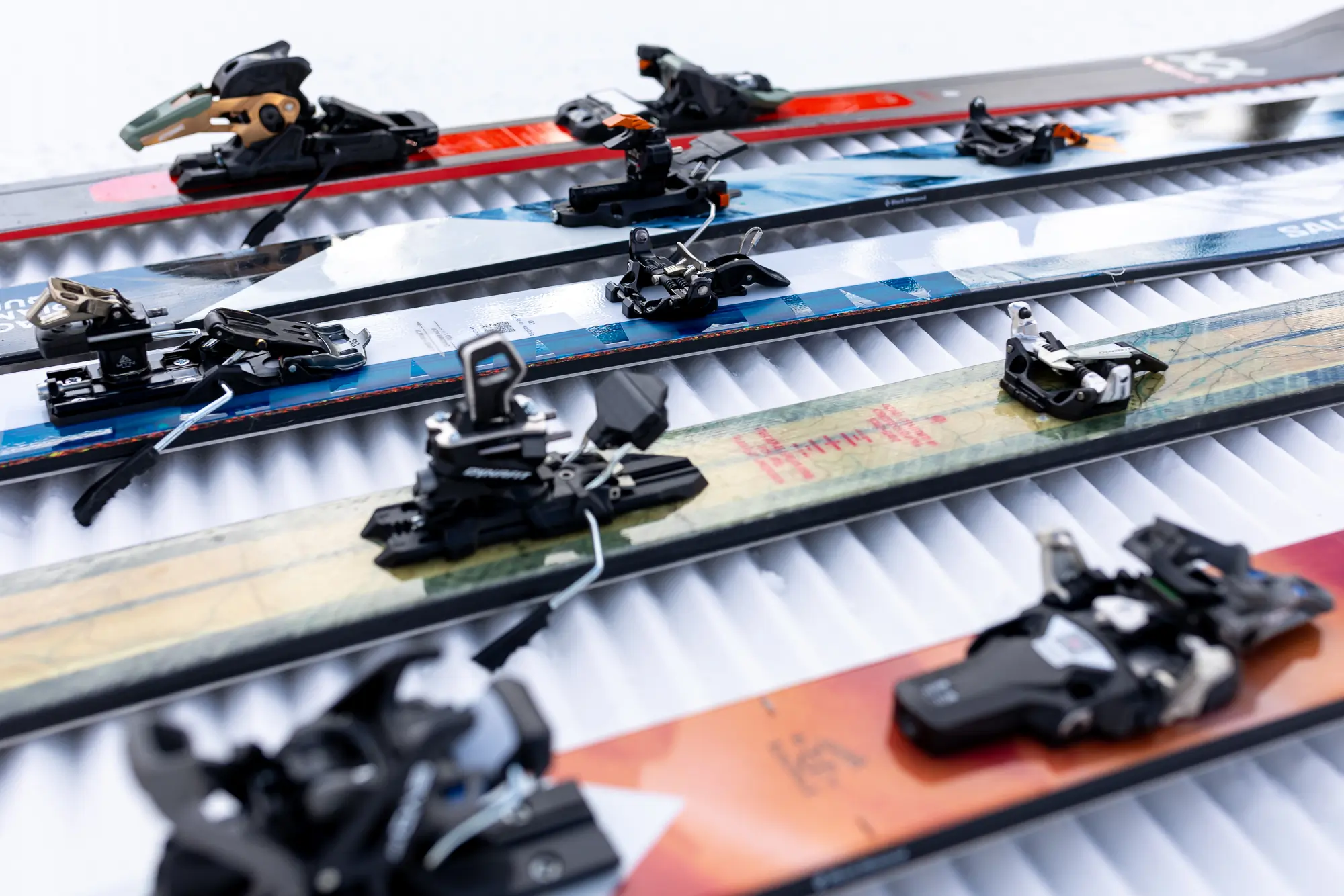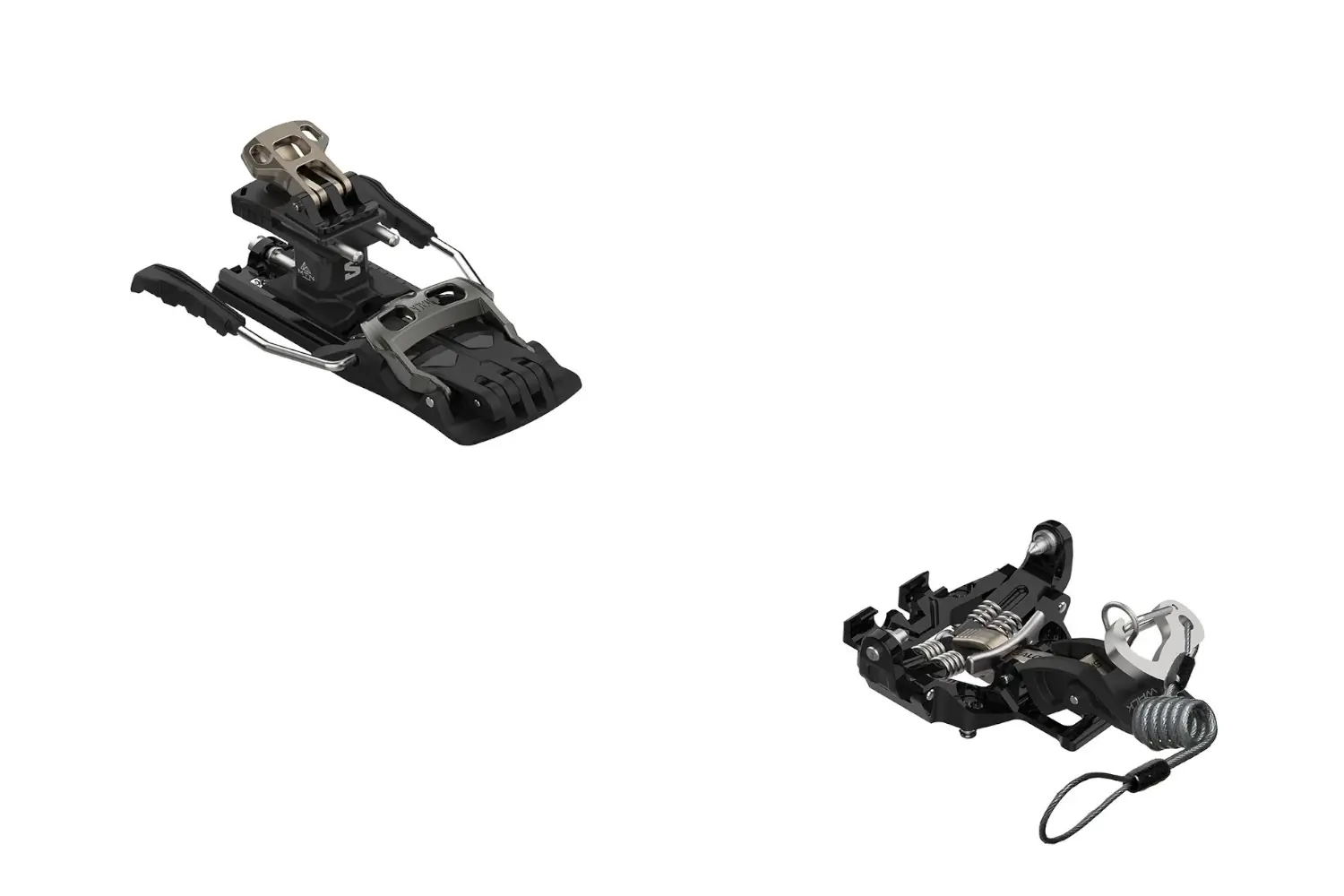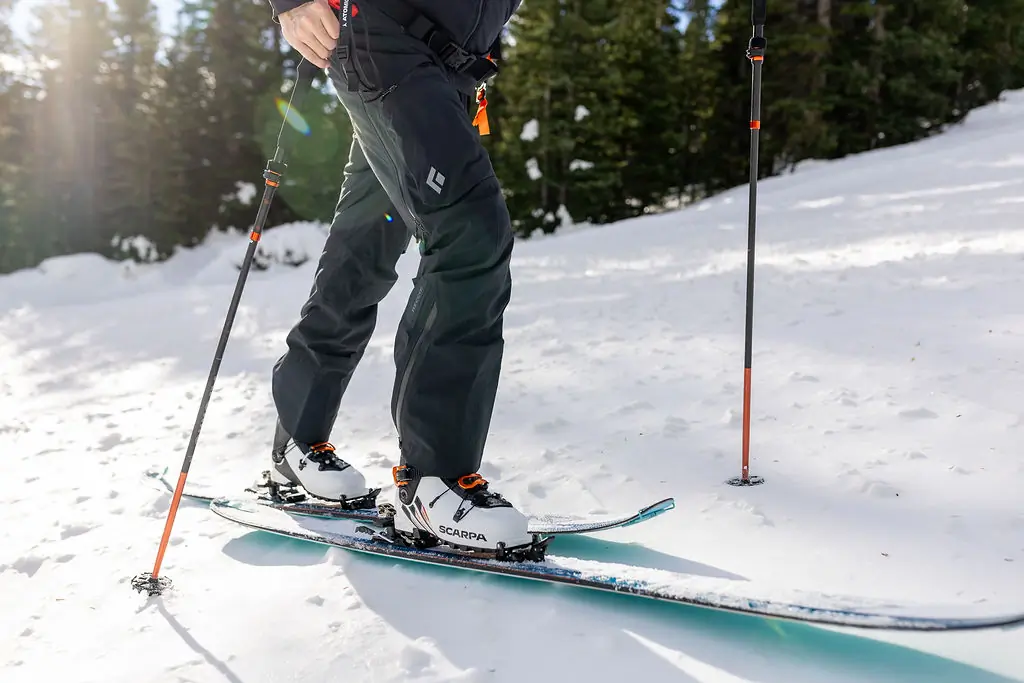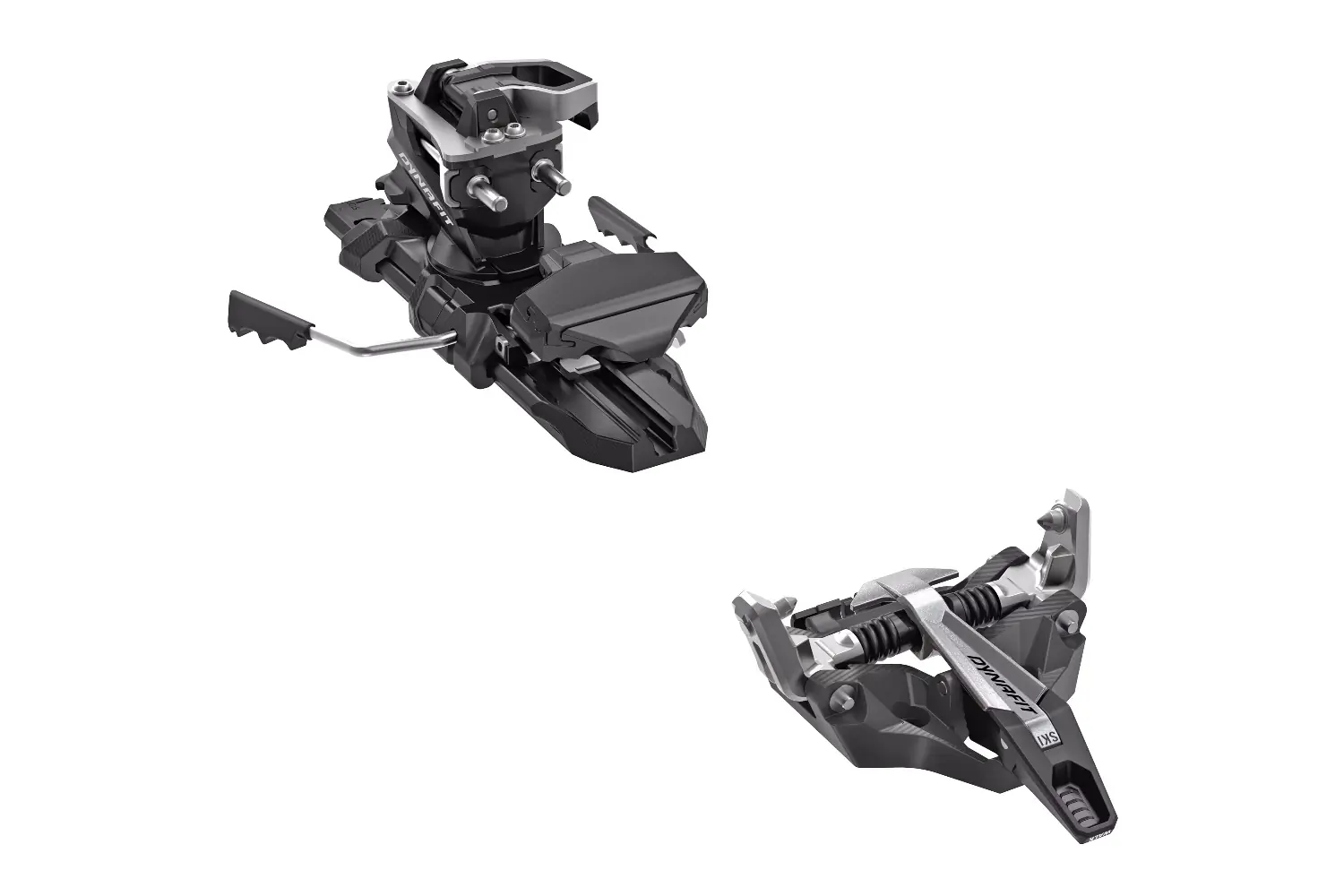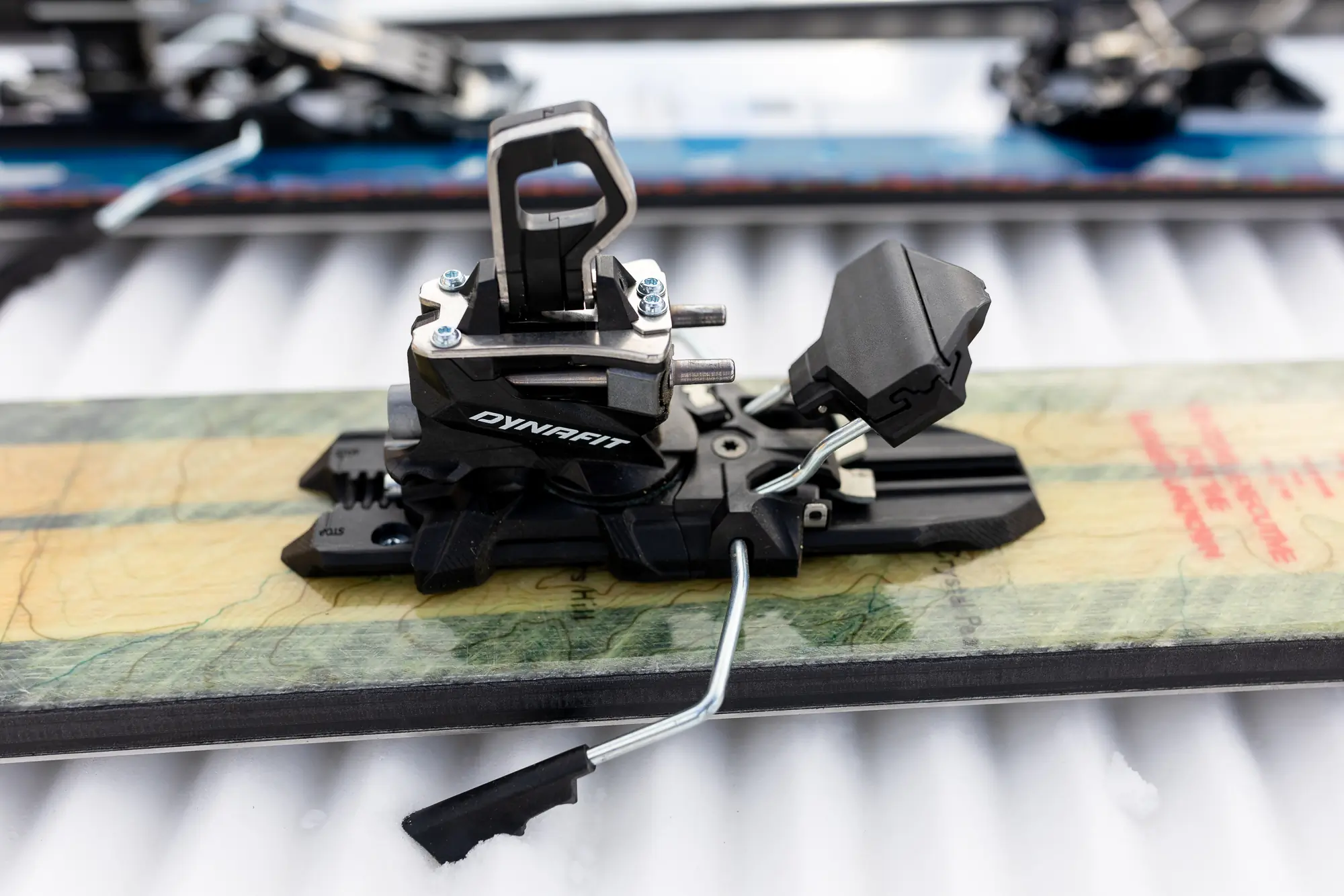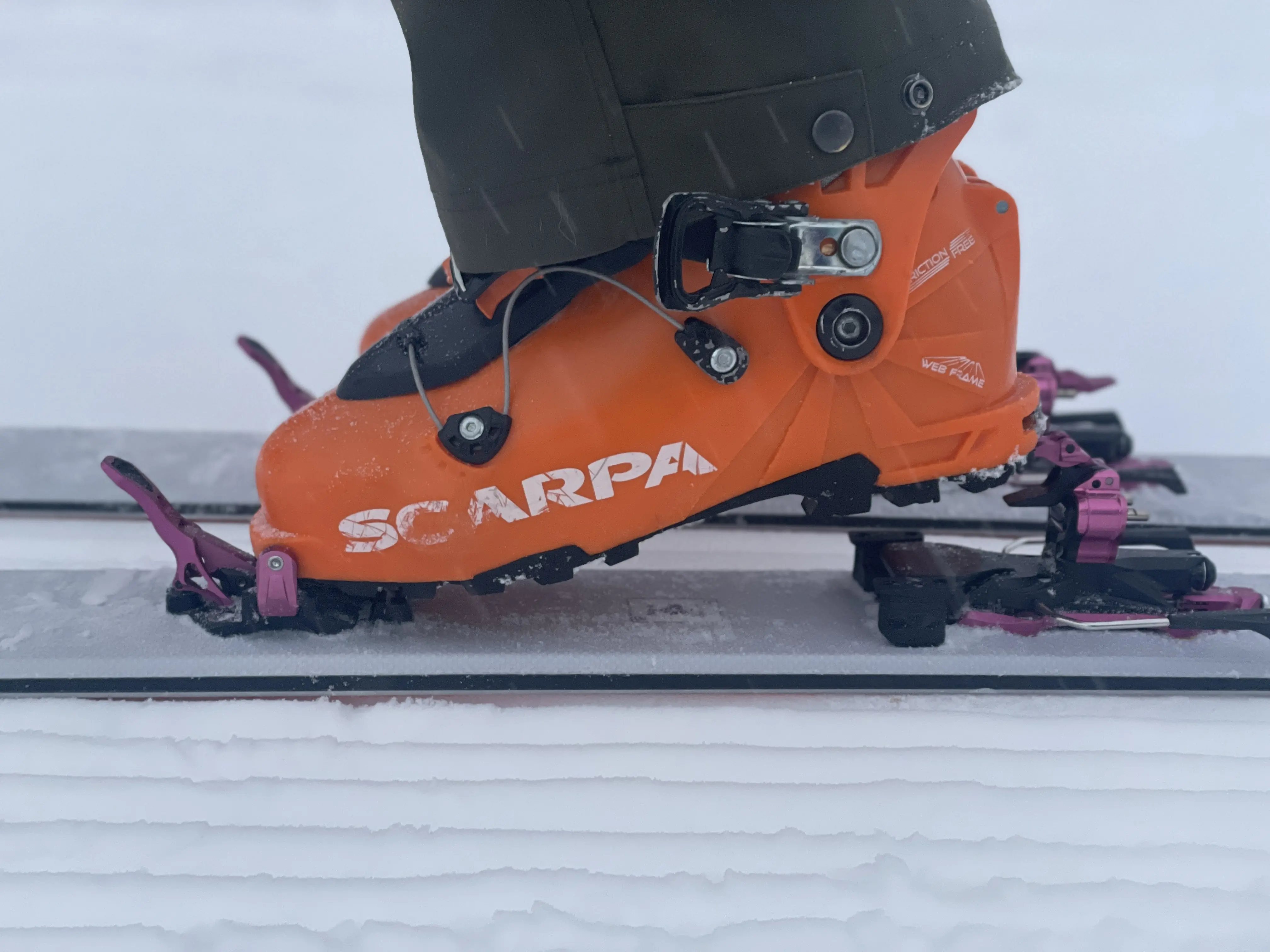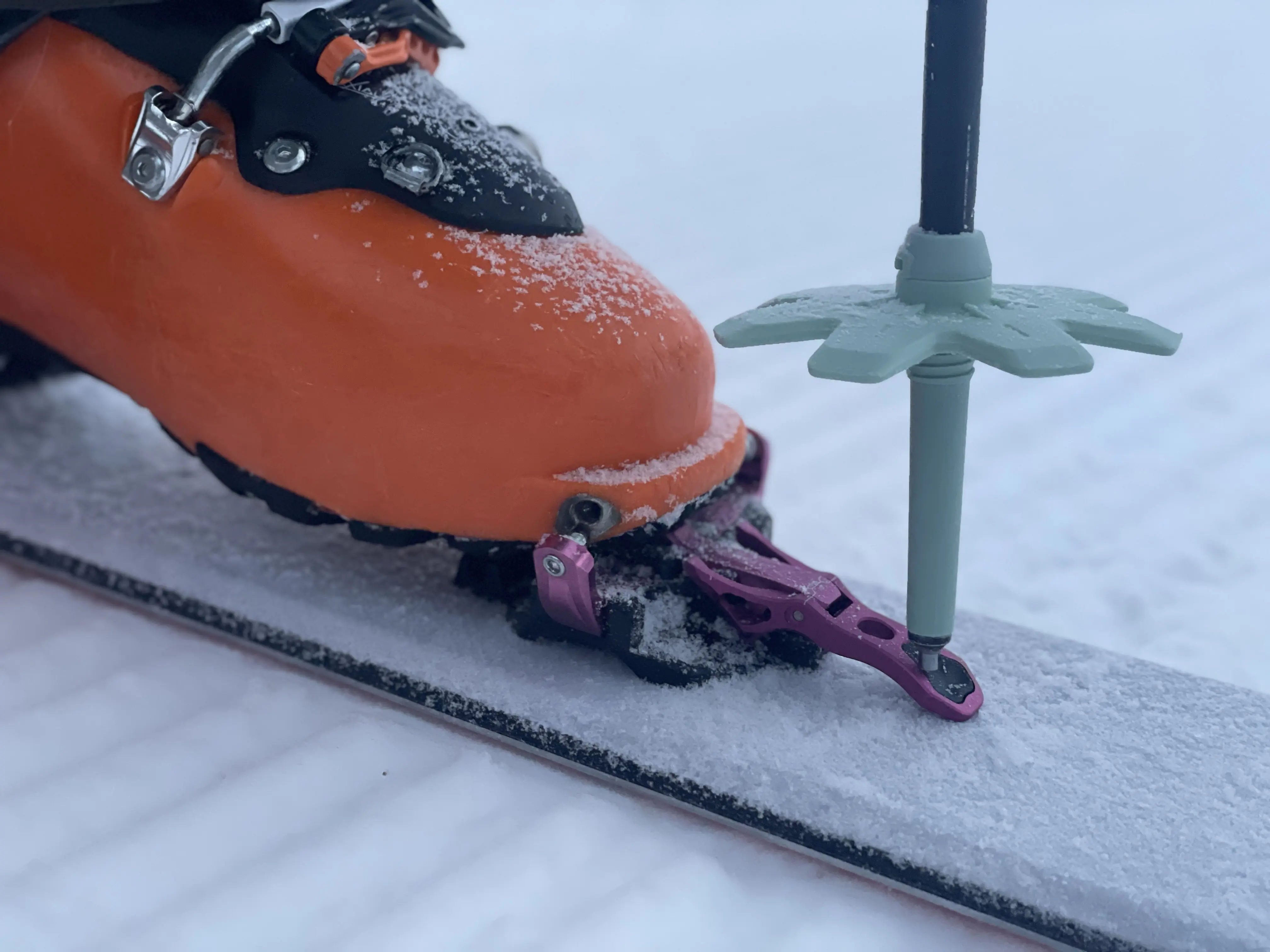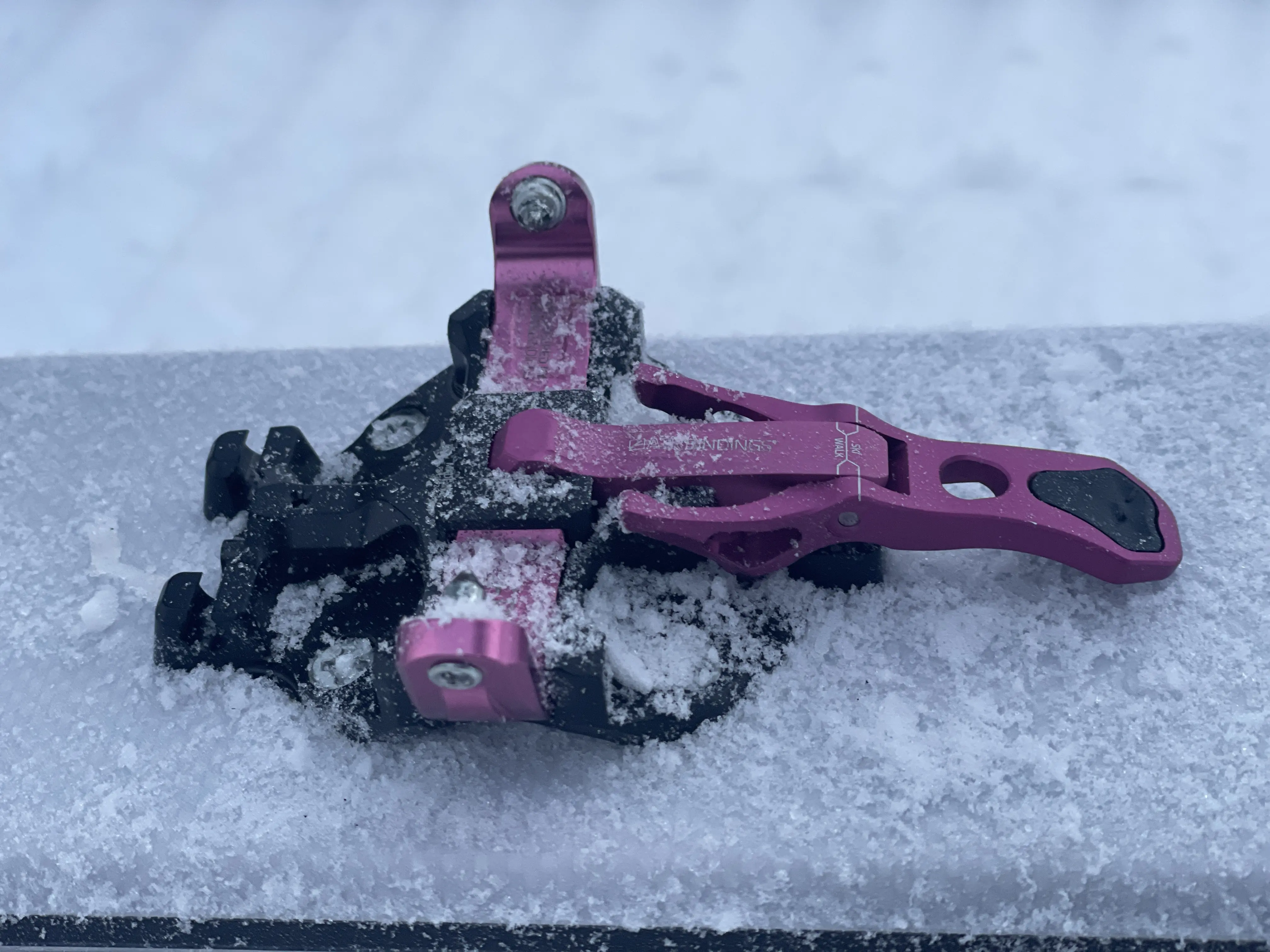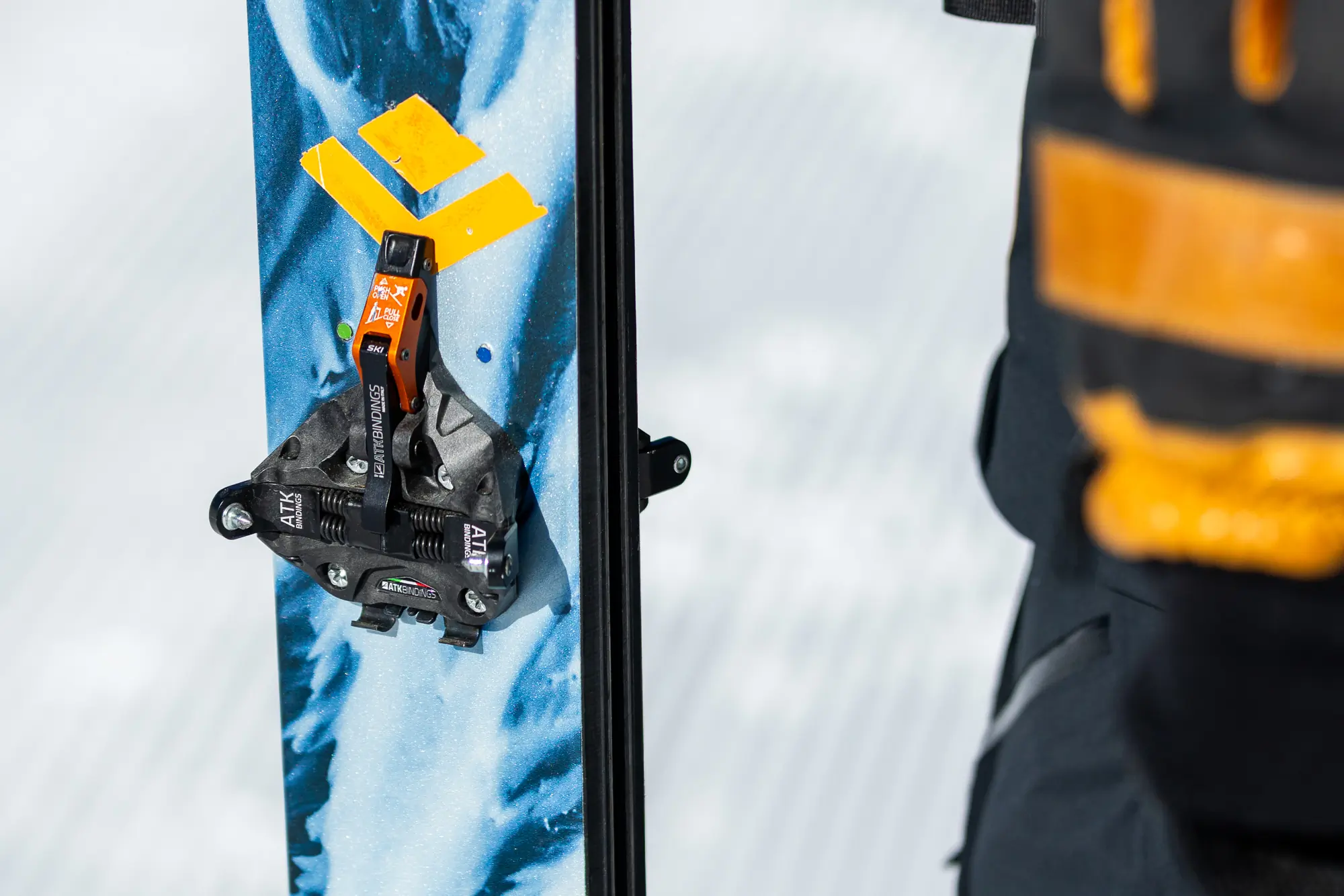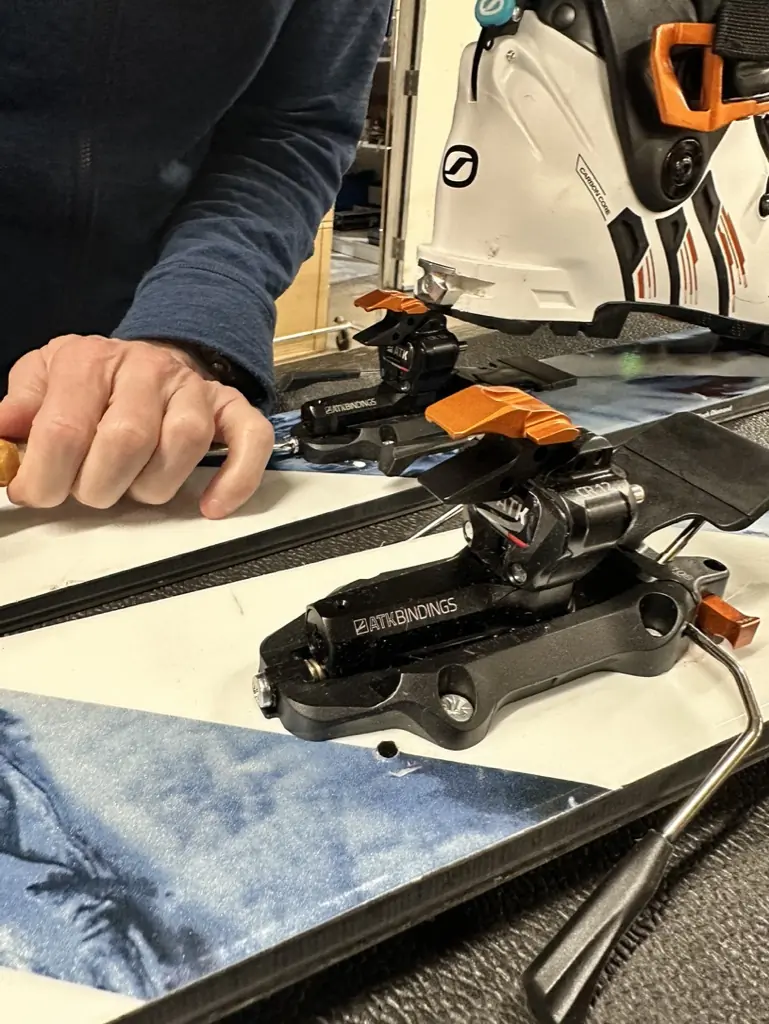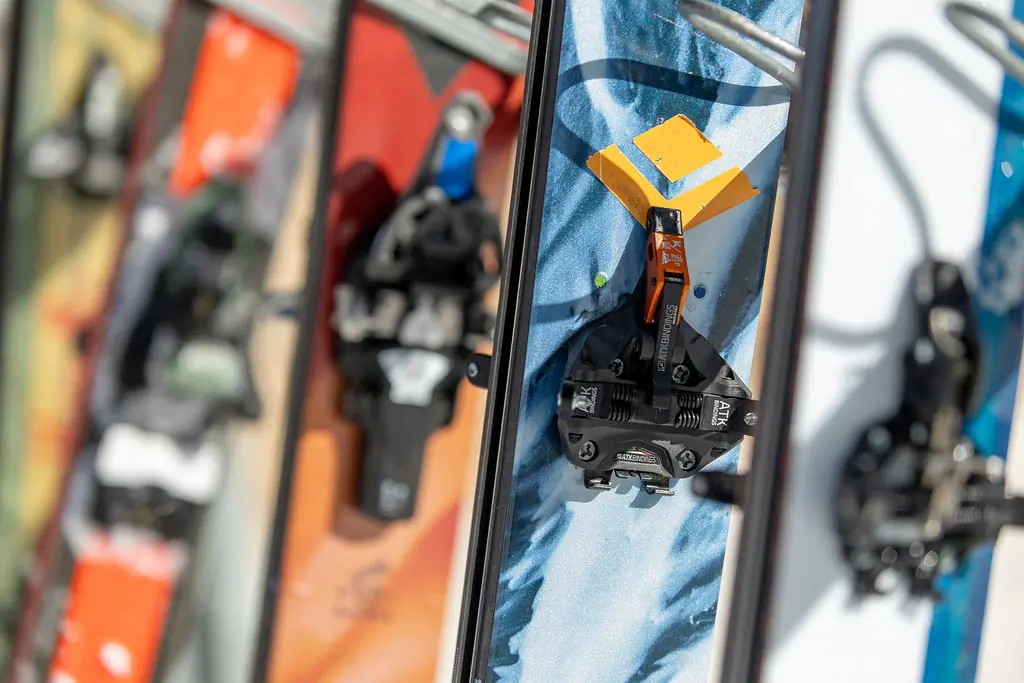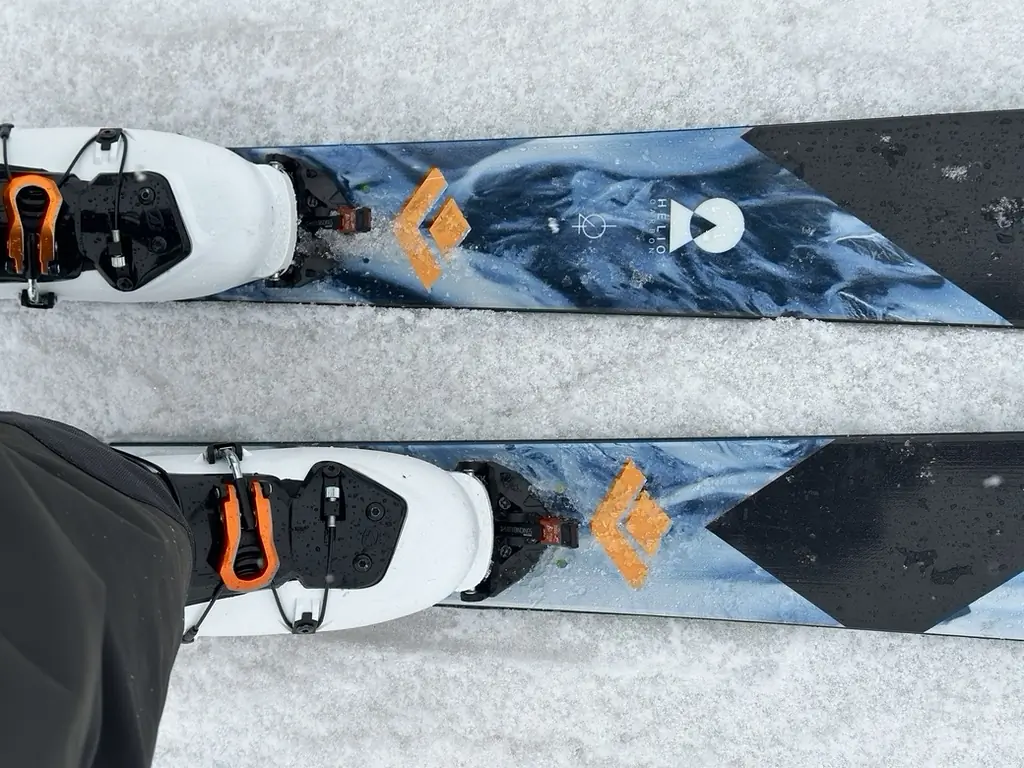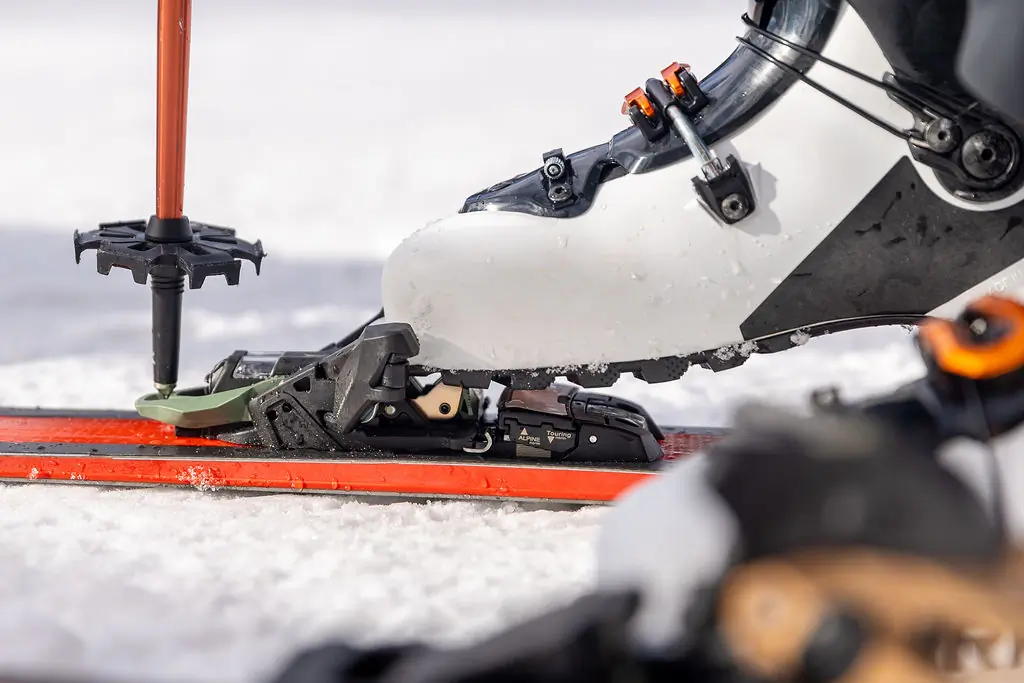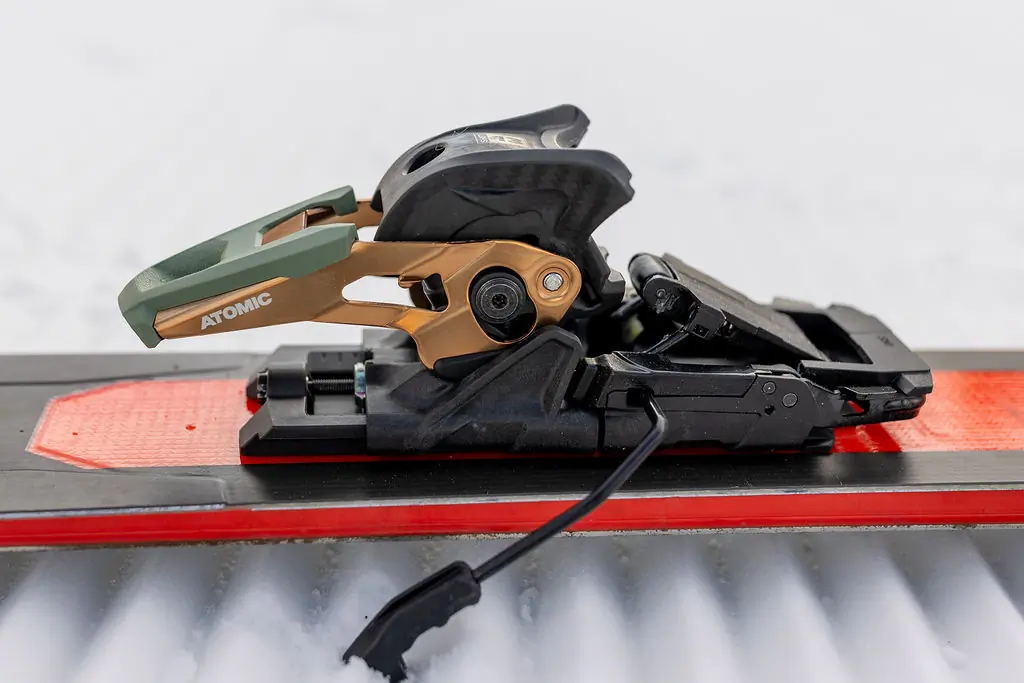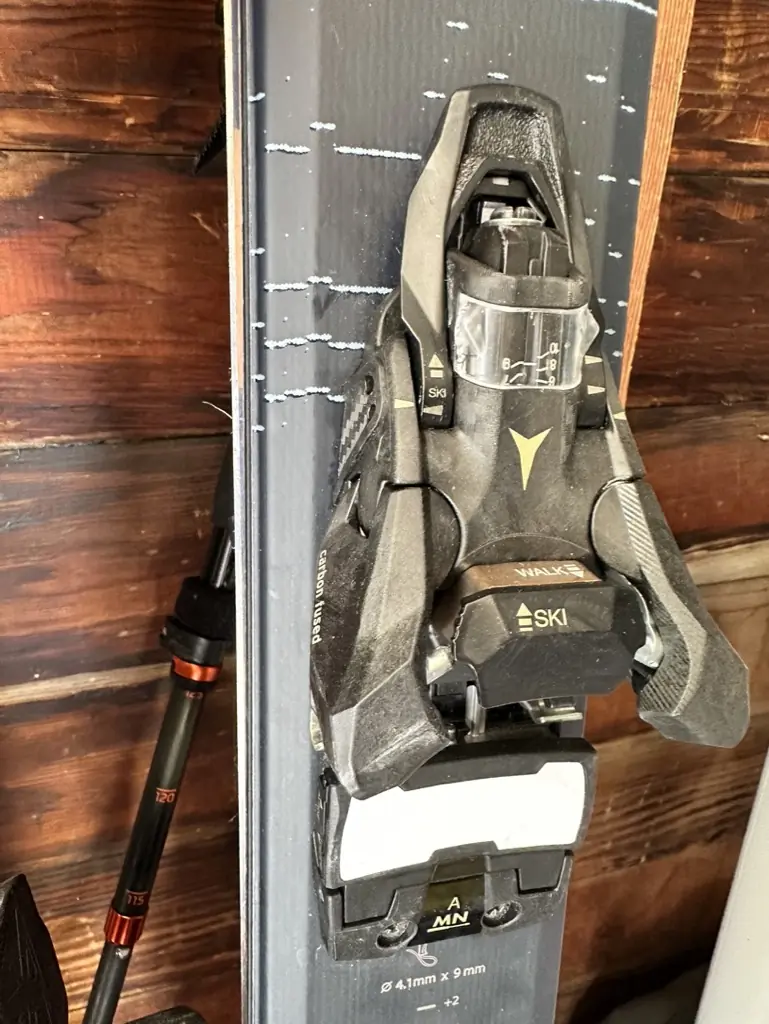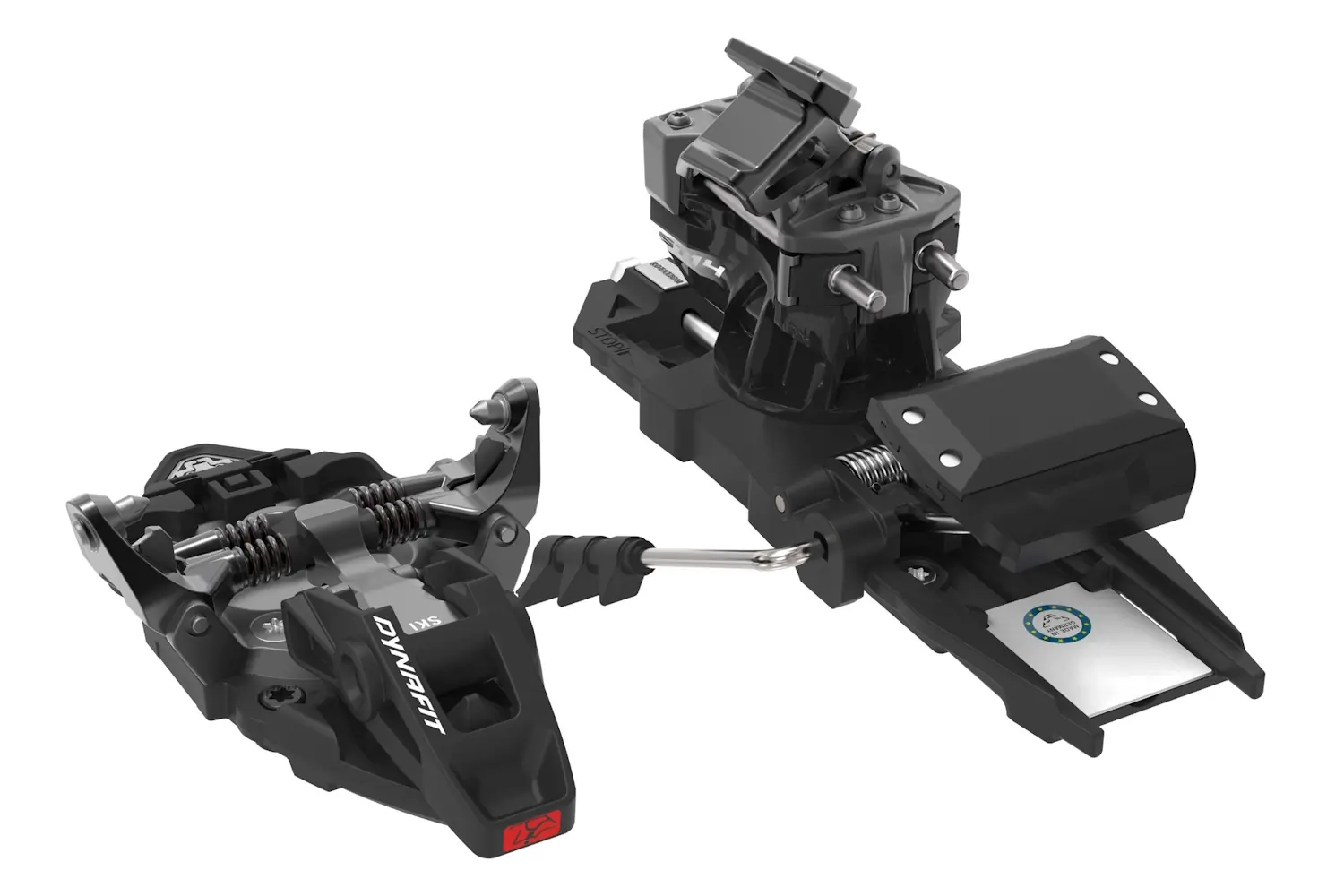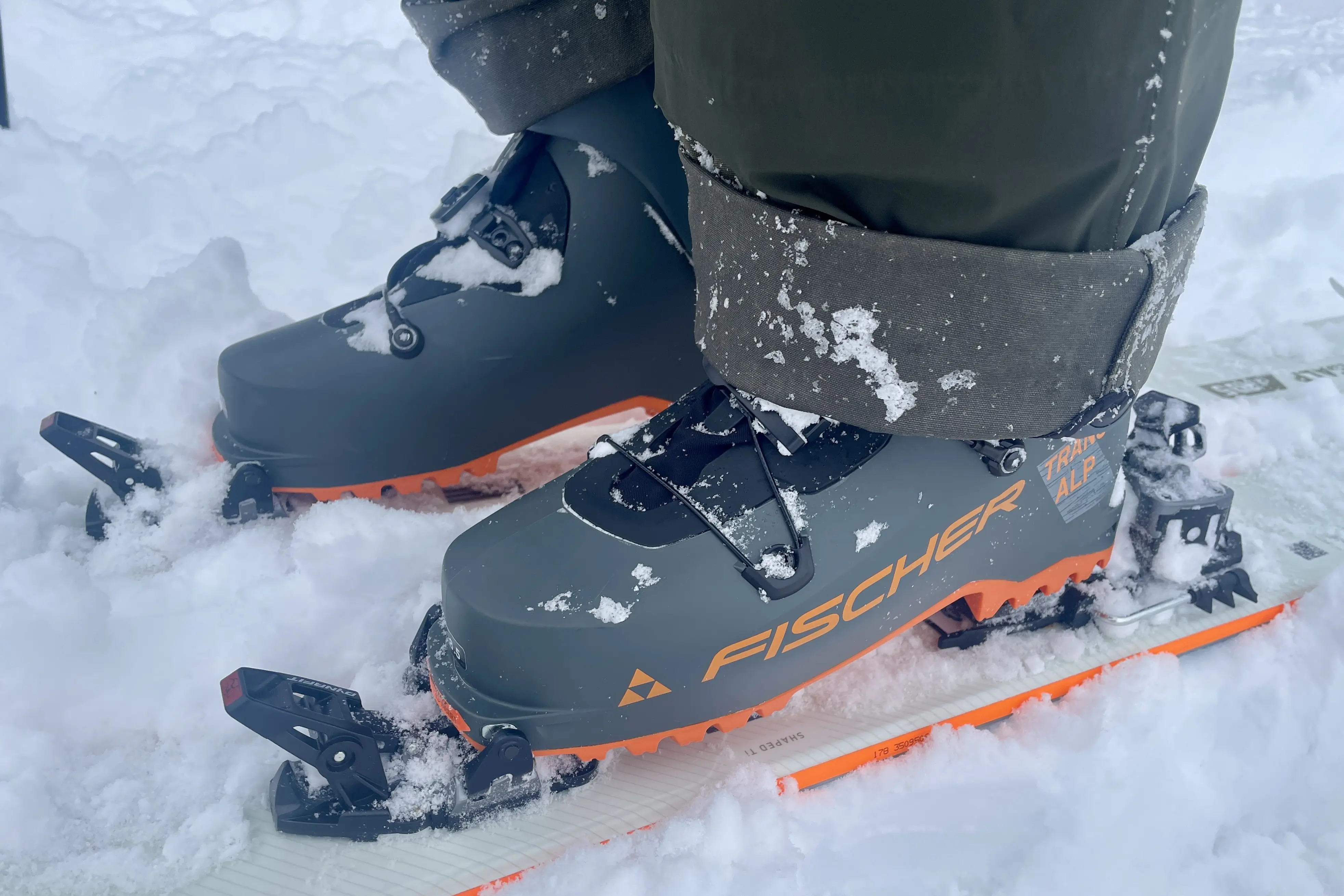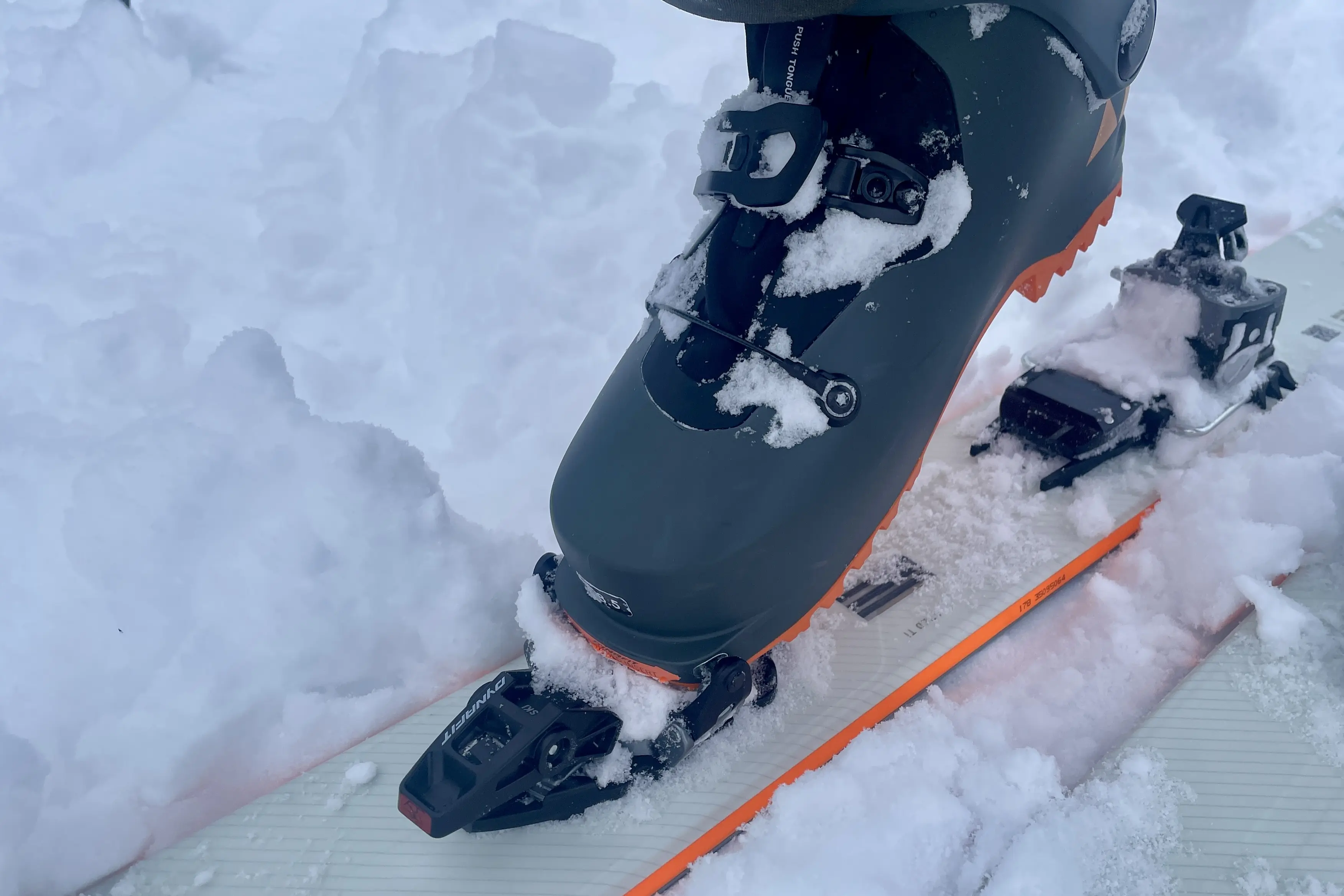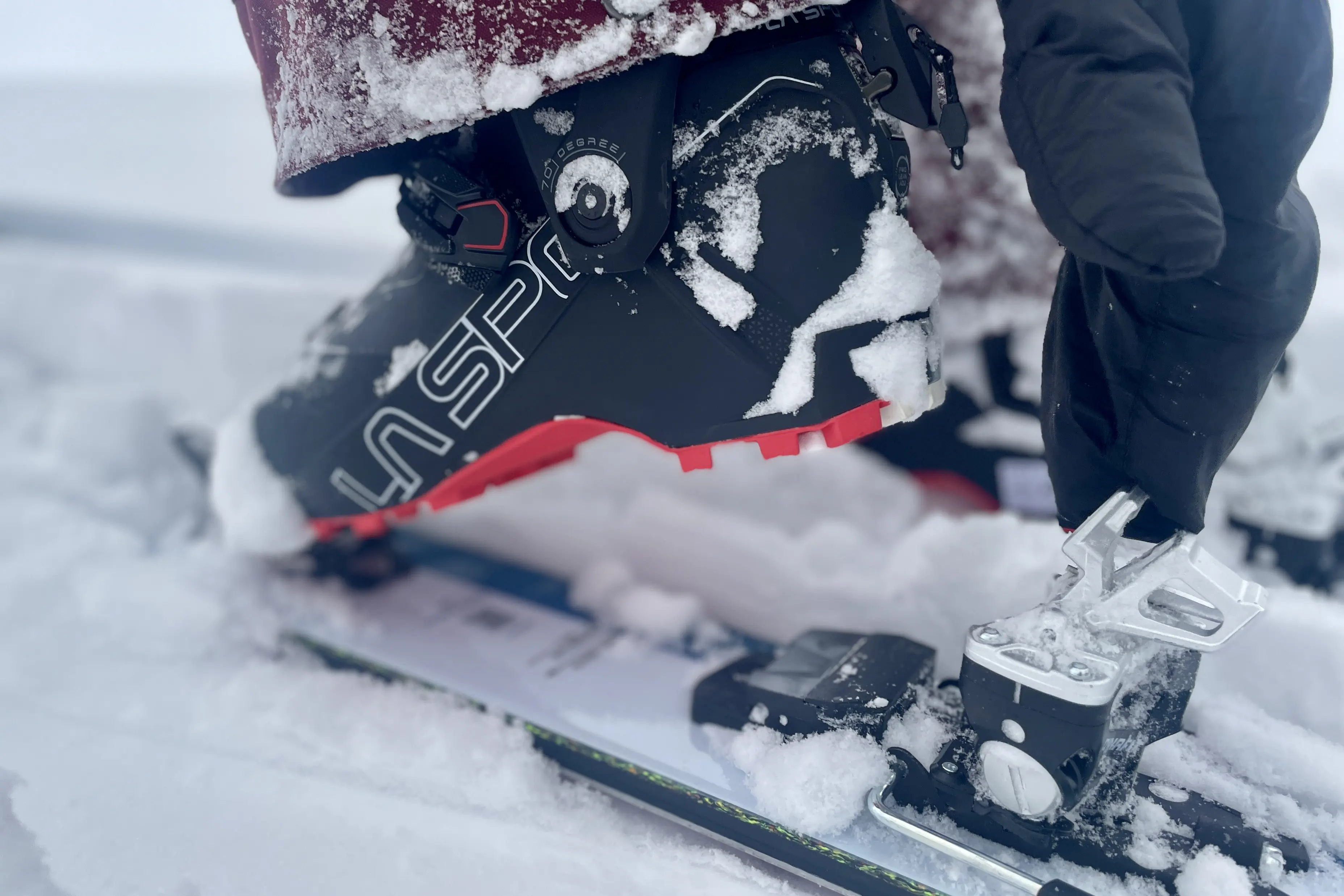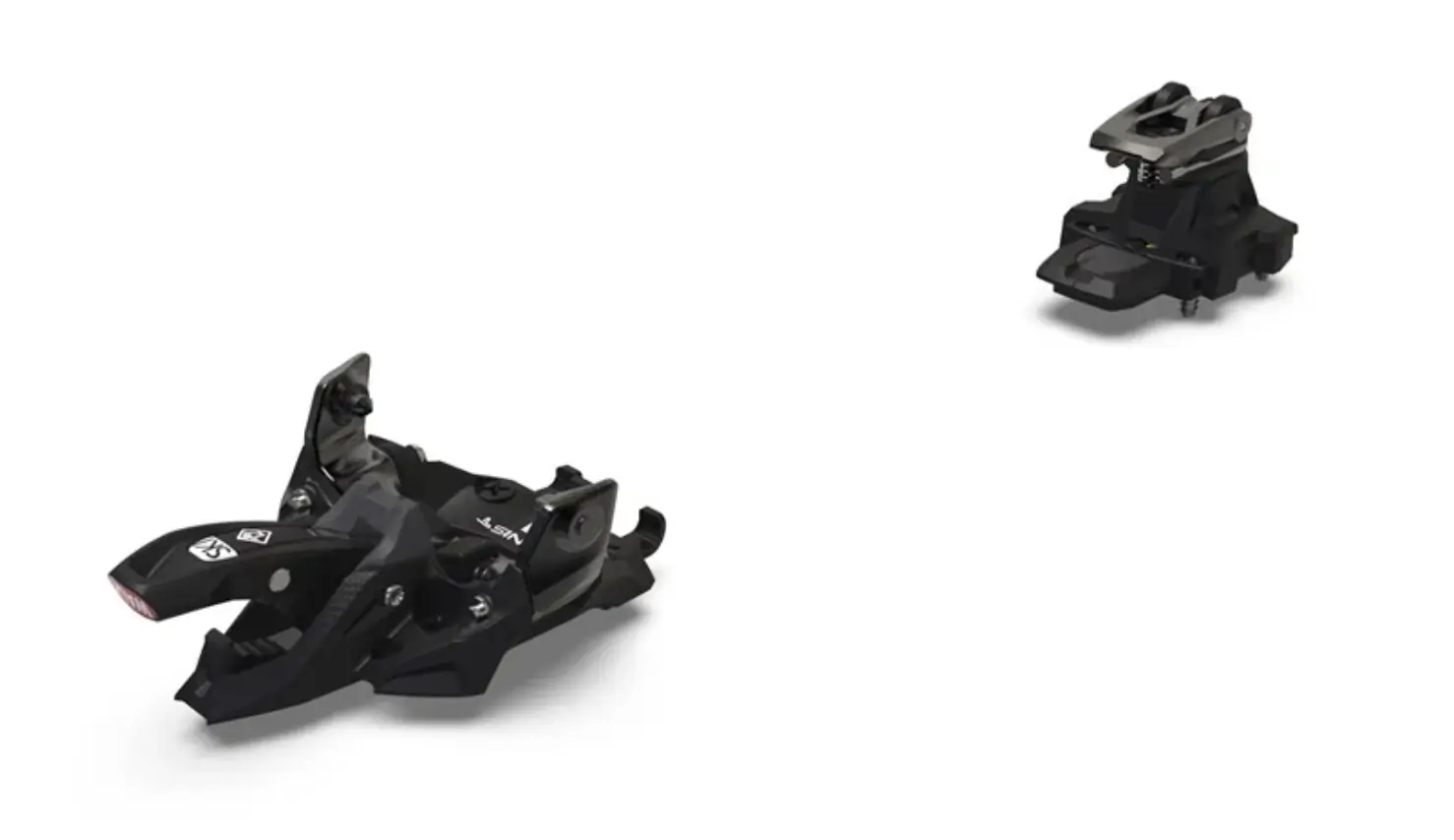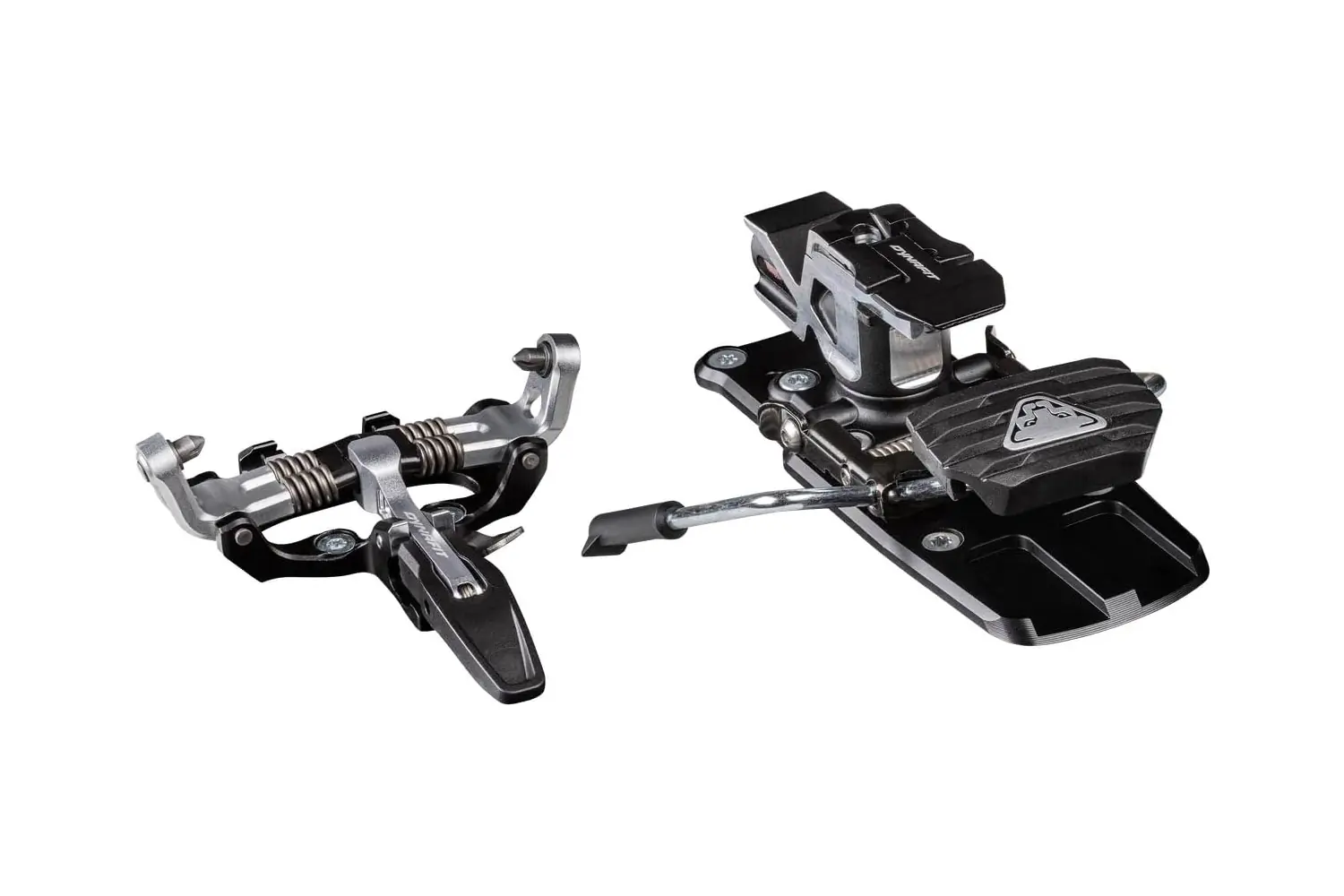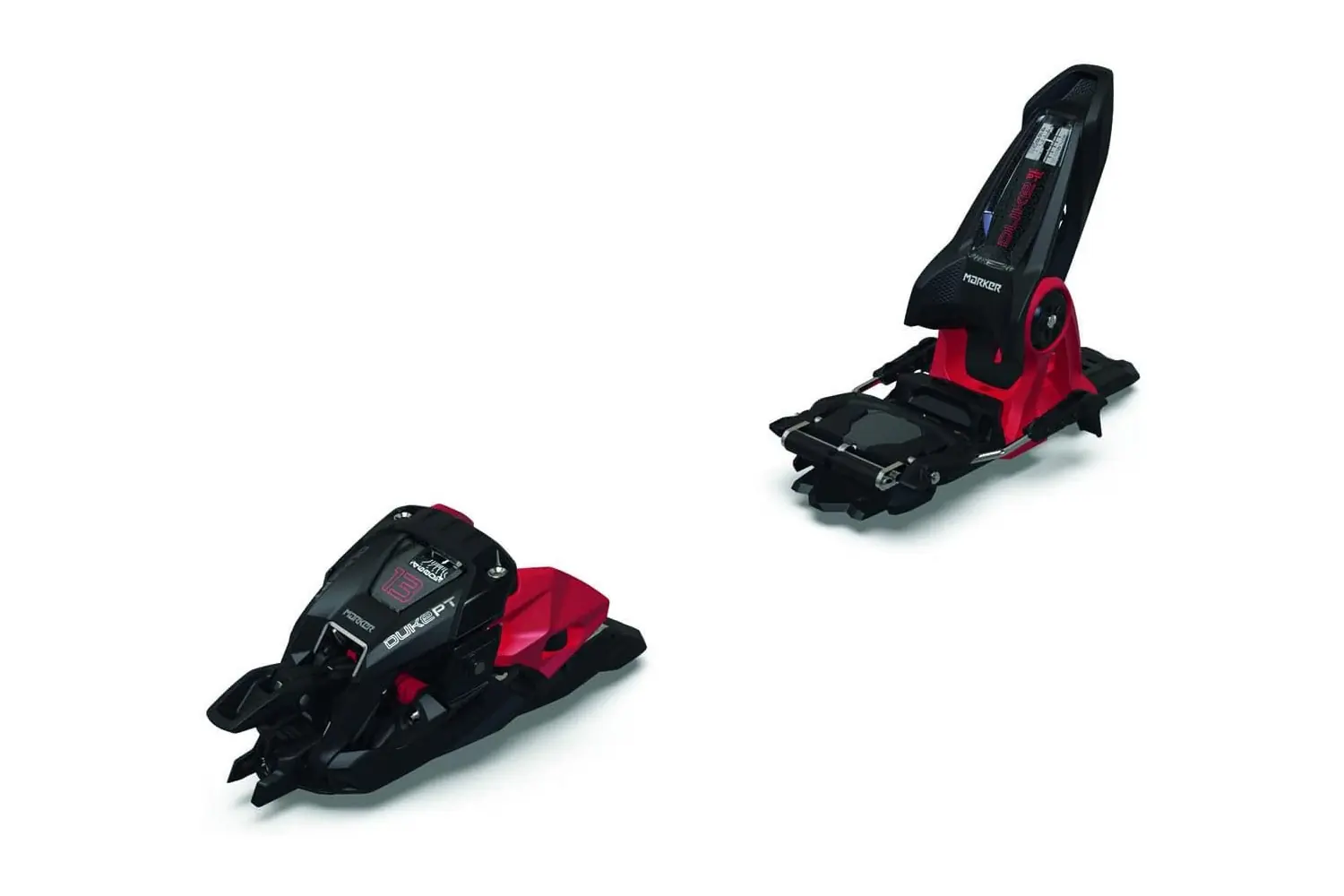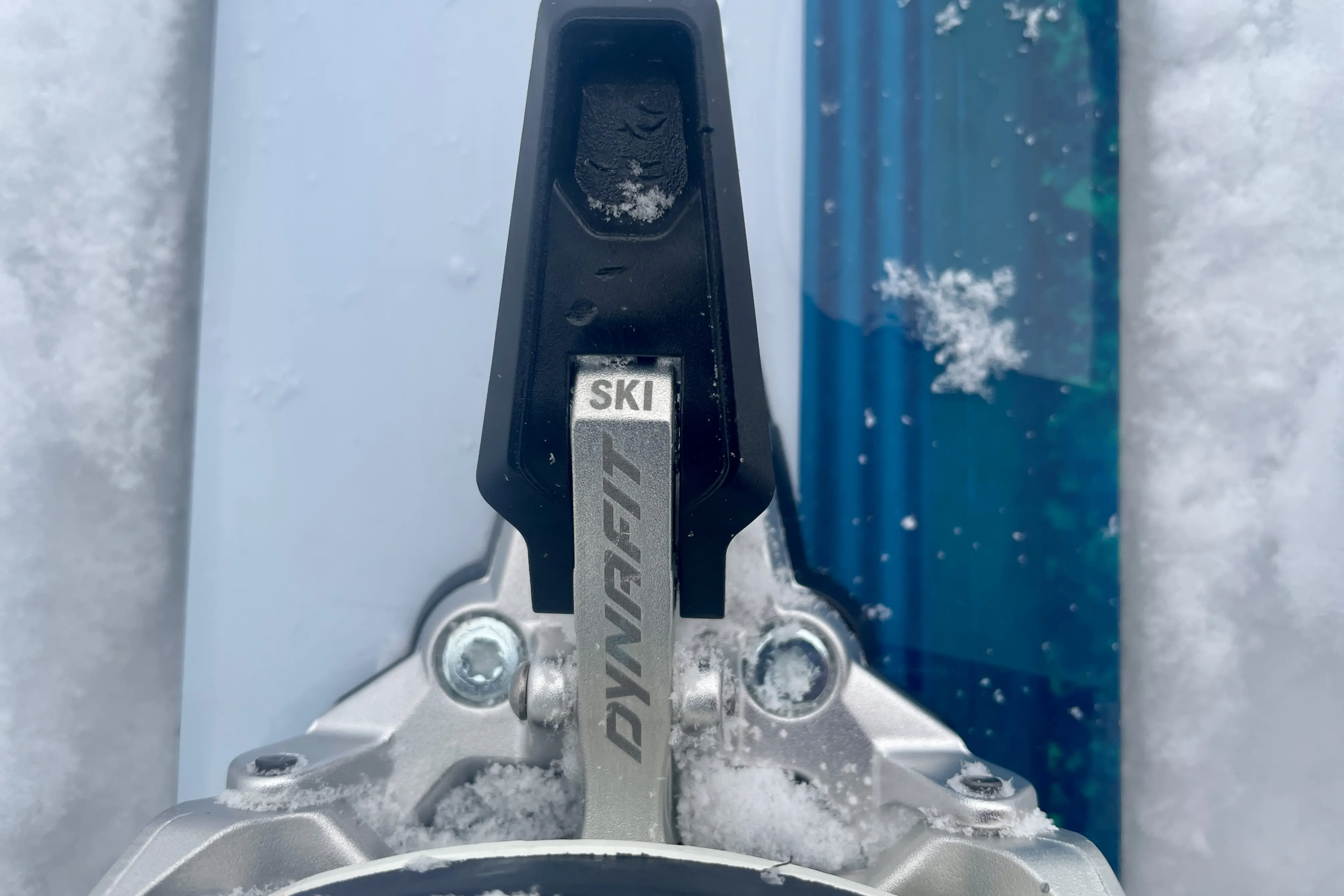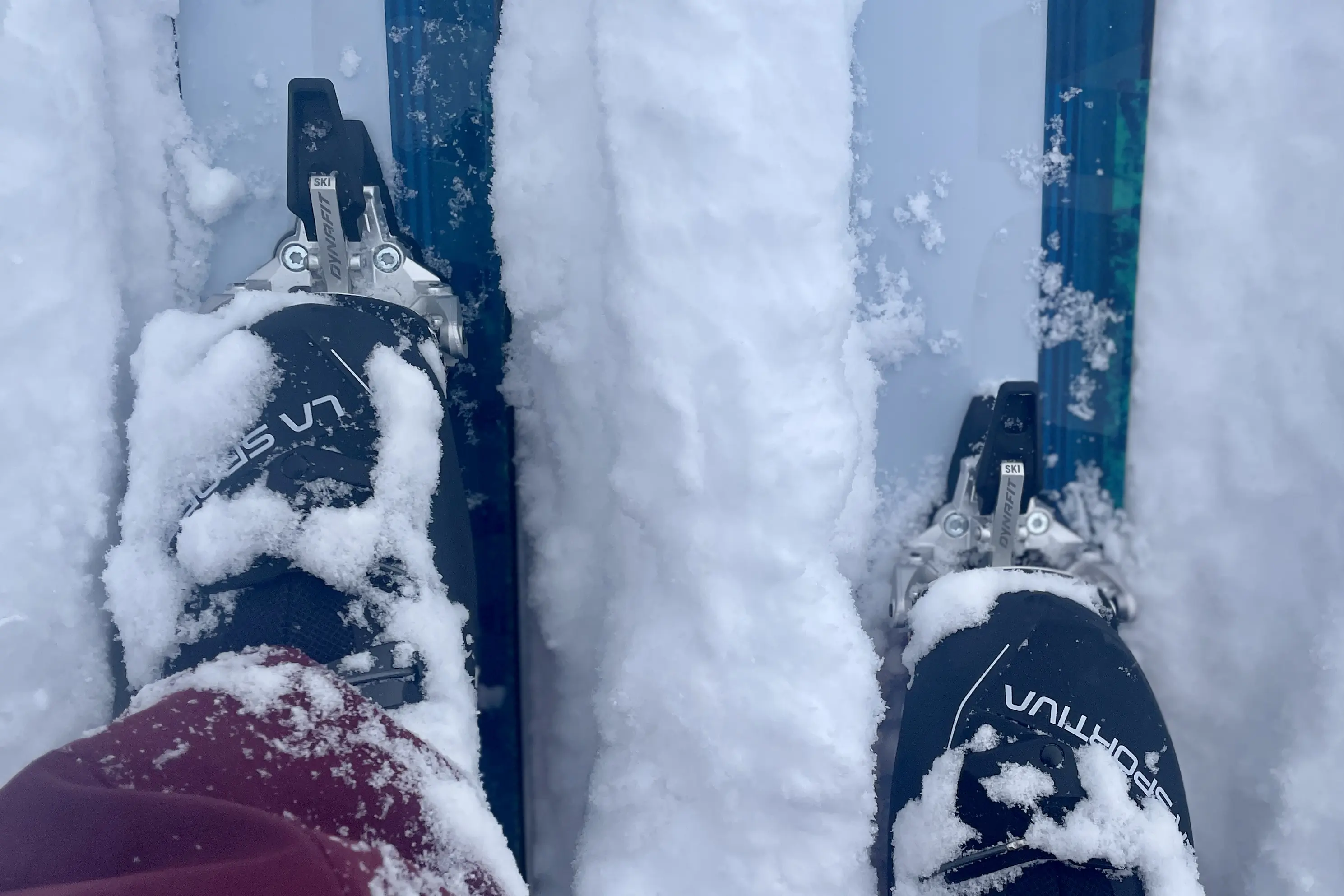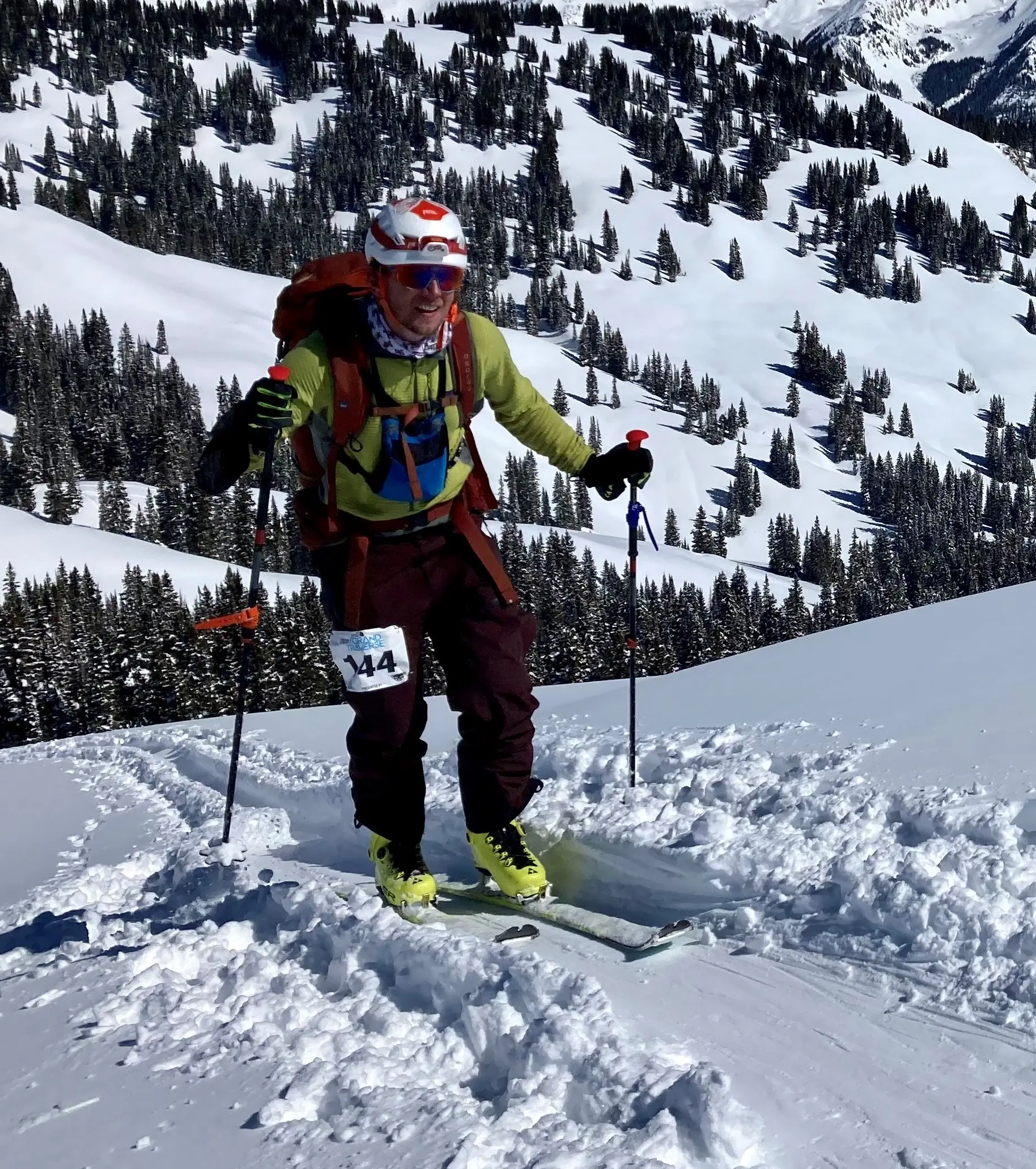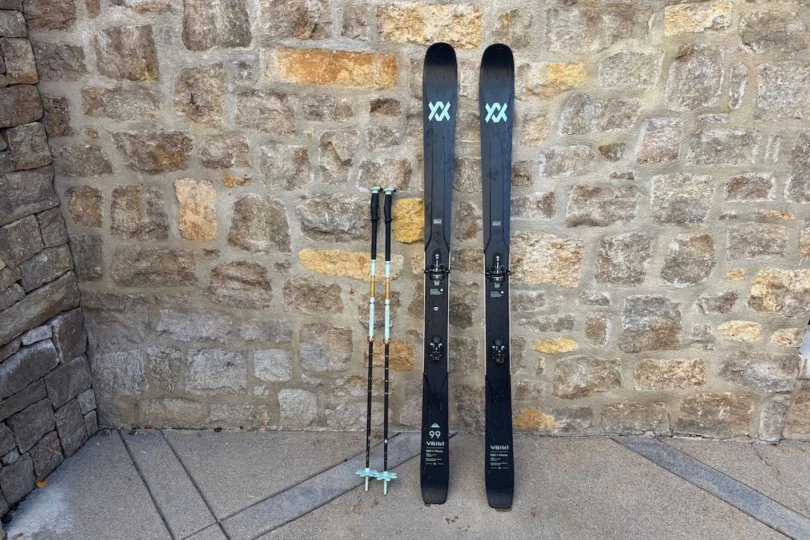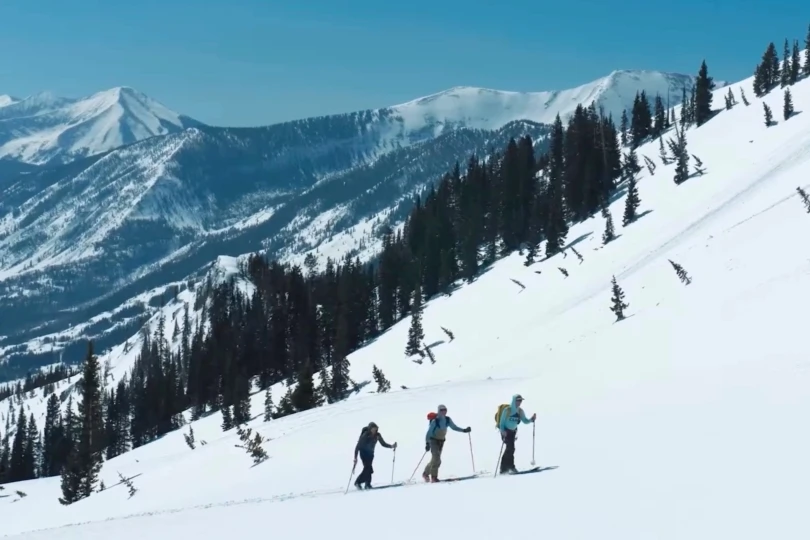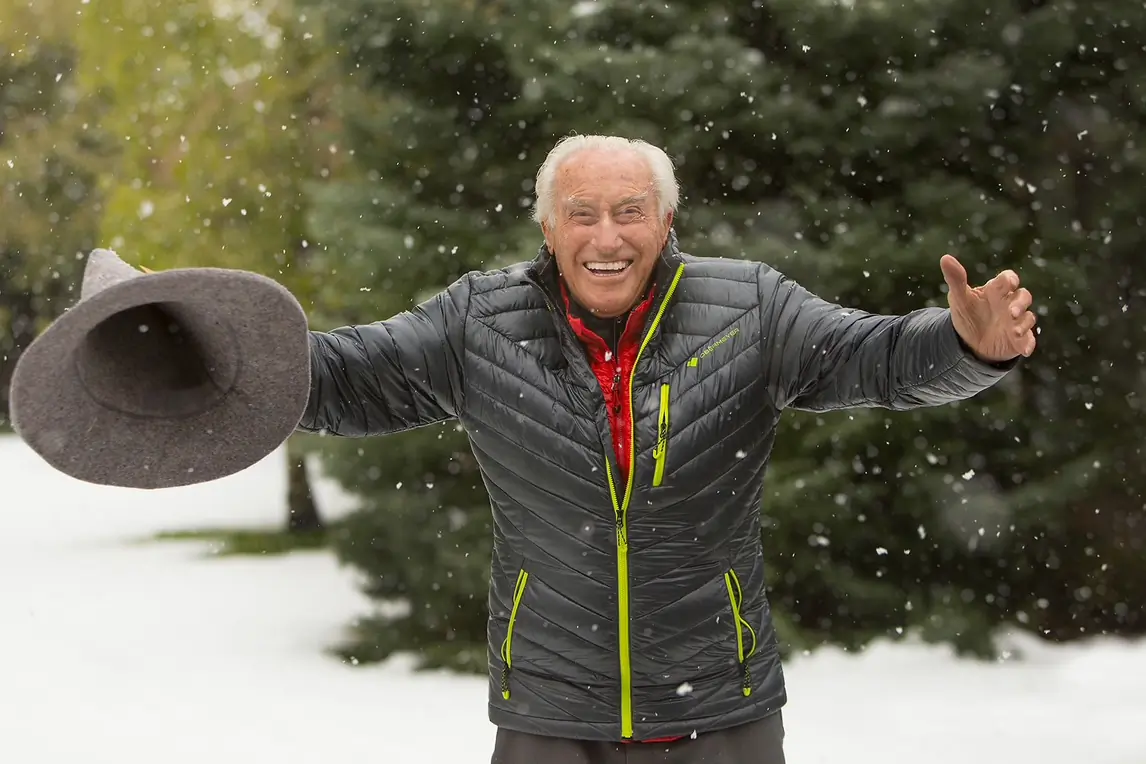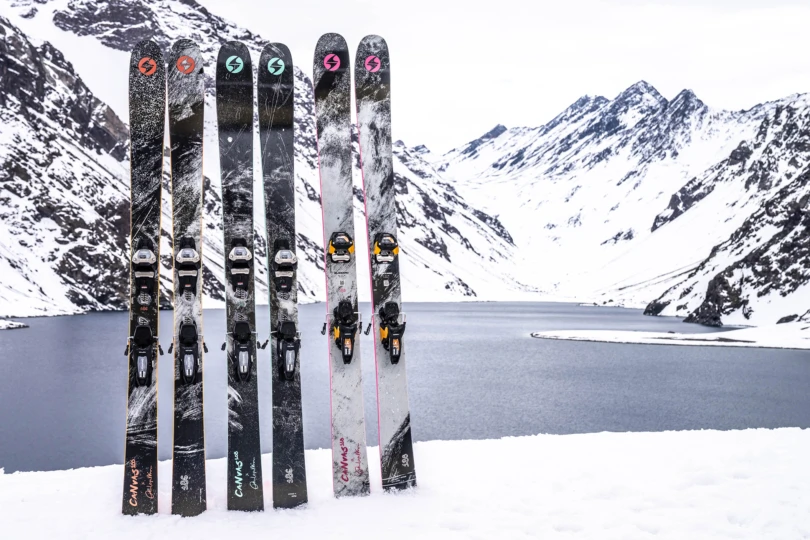Chasing winter lines under your own power starts with the best backcountry bindings. The right backcountry ski bindings can make all the difference in how far you climb and how confidently you descend. Our testing crew — backcountry powder hounds Aaron Bible and Ryan Kemper — put bindings through the wringer on resorts, glades, steeps, and switchbacks across Colorado and Wyoming.
From the Tetons to the Rockies, we skinned up and skied down in every snow condition imaginable to pinpoint the best options for every style and budget. Whether you want the all-around versatility of the Salomon MTN Pure or the value-packed performance of the Dynafit Seven Summits, these picks will keep you climbing higher and skiing harder all season.
Editor’s Note: On August 17, 2025, we updated this guide, adding the lightweight and dependable Dynafit Radical and the versatile Dynafit ST Rotation. We also added detailed ratings, which offer further insight into our testing process.
The Best Backcountry Ski Bindings of 2025
Salomon MTN Pure
-
Ease of Use
9.0
-
Durability
9.1
-
Weight
8.7
-
Performance
9.3
- Weight: 590 g/pair
- Type: Tech
- DIN: NA
Pros
- Very light
- Durable
- Easy to click in toe
Cons
- DIN may not be high enough for aggressive riders
Dynafit Seven Summits
-
Ease of Use
7.5
-
Durability
7.9
-
Weight
8.3
-
Performance
8.0
- Weight: 640 g/pair
- Type: Tech
- DIN: 4-10
Pros
- Great value
- Durable
- Reliable entry with improved toe piece technology
- Safe brake system
Cons
- Might be too lightweight for some resort use
- DIN only goes to 10
ATK Freeraider 15 Evo
-
Ease of Use
9.0
-
Durability
8.7
-
Weight
8.9
-
Performance
9.5
- Weight: 790 g/pair
- Type: Tech
- DIN: 7-15
Pros
- Top-notch uphill and downhill performance
- Thoughtful features
- Relatively lightweight
- Easy and intuitive to use
- Super fun color options
Cons
- High-performance pricing
G3 ION 12
-
Ease of Use
8.5
-
Durability
9.0
-
Weight
7.0
-
Performance
8.6
- Weight: 1158 g/pair
- Type: Tech
- DIN: 5-12
Pros
- Easy step-in
- Extremely versatile
- Tried and true; icon in the industry
- Optimal heel lift
- Very skier-friendly and intuitive to use
Cons
- To the extreme weight-saver, may be a tad heavy
ATK Raider 13 Evo
-
Ease of Use
8.3
-
Durability
9.0
-
Weight
8.0
-
Performance
8.7
- Weight: 740 g/pair
- Type: Tech
- DIN: 5-13
Pros
- Simple
- Light
- Versatile for all types of skiers
- Durable
- Easy to click in
Cons
- Lesser-known brand
- Some larger skiers may want a higher DIN rating
- Not the lightest on the market
Salomon/Atomic SHIFT 2
-
Ease of Use
7.0
-
Durability
8.4
-
Weight
6.2
-
Performance
8.7
- Weight: 1840 g/pair
- Type: Tech Hybrid
- DIN: 6-13
Pros
- Allows for more aggressive skiing
- Versatile for more skiers
- Accommodates alpine, grip walk, tech, and touring boot soles
Cons
- Though lighter than frame bindings, these are still on the heavy side for touring
- A bit more to fiddle with, and more steps to transition than traditional tech pins
Other Backcountry Ski Bindings We Trust
-
Ease of Use
7.9
-
Durability
8.3
-
Weight
6.8
-
Performance
8.0
- Weight: 1212 g/pair
- Type: Tech
- DIN: 7-14
Pros
- Rotating toe releases reliably when needed
- Stays composed in firm and variable conditions
- Heel risers and ski-walk mode work well with gloves
- Solid construction stands up to multi-season use
Cons
- Heavier than minimalist tech bindings
- Stepping in takes practice
-
Ease of Use
7.5
-
Durability
6.0
-
Weight
7.9
-
Performance
8.0
- Weight: 840 g/pair
- Type: Tech
- DIN: 4-12
Pros
- Very easy heel transition from walk to ski mode
- Lightweight, high-performance bindings
- Easy to line up boot and pins with "toe stopper"
- Automatic brake engage/disengage with heel transition
Cons
- Some small, moving parts that could be affected by severe/prolonged cold
- Require special Dynafit jig to mount that not every shop carries
-
Ease of Use
7.0
-
Durability
8.0
-
Weight
8.0
-
Performance
6.9
- Weight: 540 g/pair
- Type: Tech
- DIN: 6-12
Pros
- Good downhill performance
- Lightweight
Cons
- Release values are not DIN certified
-
Ease of Use
7.8
-
Durability
7.6
-
Weight
8.5
-
Performance
6.9
- Weight: 716 g/pair
- Type: Tech
- DIN: 5-12
Pros
- Good range of adjustment
- Easy to engage heel risers
- Good value
Cons
- Just a touch on the heavy side
-
Ease of Use
5.5
-
Durability
7.0
-
Weight
9.0
-
Performance
6.0
- Weight: 320 g/pair
- Type: Tech
- DIN: 4-13
Pros
- Ultralight
- Durable
Cons
- Heel piece requires rotation to adjust riser height
-
Ease of Use
5.0
-
Durability
8.0
-
Weight
4.0
-
Performance
7.0
- Weight: 2600 g/pair
- Type: Hybrid
- DIN: 4-13
Pros
- A good compromise of uphill and downhill performance
Cons
- Heavy
- Expensive compared true tech pin bindings
-
Ease of Use
7.5
-
Durability
8.0
-
Weight
6.8
-
Performance
8.0
- Weight: 1040 g/pair
- Type: Tech
- DIN: 4-10
Pros
- Proven tech binding design with solid reliability
- Lightweight enough for full-day tours
- Predictable release
- Good value for skiers who want a no-frills binding
Cons
- Transitions feel slower due to manual heel rotation
- Feels stiffer on the descent in variable conditions
Backcountry Ski Bindings Comparison Chart
| Binding | Price | Weight (per pair) | Type | DIN Range |
|---|---|---|---|---|
| Salomon MTN Pure/Atomic Backland | $650 | 590 g/pair | Tech | NA |
| Dynafit 7 Summits | $350-430 | 640 g/pair (without brakes) | Tech | 4-10 |
| ATK Freeraider 15 Evo | $760 | 790 g/pair | Tech | 7-15 |
| G3 Ion 12 | $664 | 1,158 g/pair | Tech | 5-12 |
| ATK 13 Raider Evo | $700 | 740 g/pair | Tech | 5-13 |
| Dynafit ST Rotation 14 | $600 | 1,212 g/pair | Tech | 7-14 |
| Dynafit Ridge | $600 | 840 g/pair | Tech | 4-12 |
| Salomon/Atomic Shift 2 | $600-650 | 1,840 g/pair | Tech Hybrid | 6-13 |
| G3 Zed 12 | $572 | 716 g/pair | Tech | 5-12 |
| Marker Alpinist 12 | $550 | 540 g/pair | Tech | 6-13 |
| Dynafit Superlite 150 | $600 | 320 g/pair | Tech | 4-13 |
| Marker Duke PT 13 | $650 | 2,600 g/pair | Hybrid | 4-13 |
| Dynafit Radical | $400 | 1,040 g/pair | Tech | 4-10 |
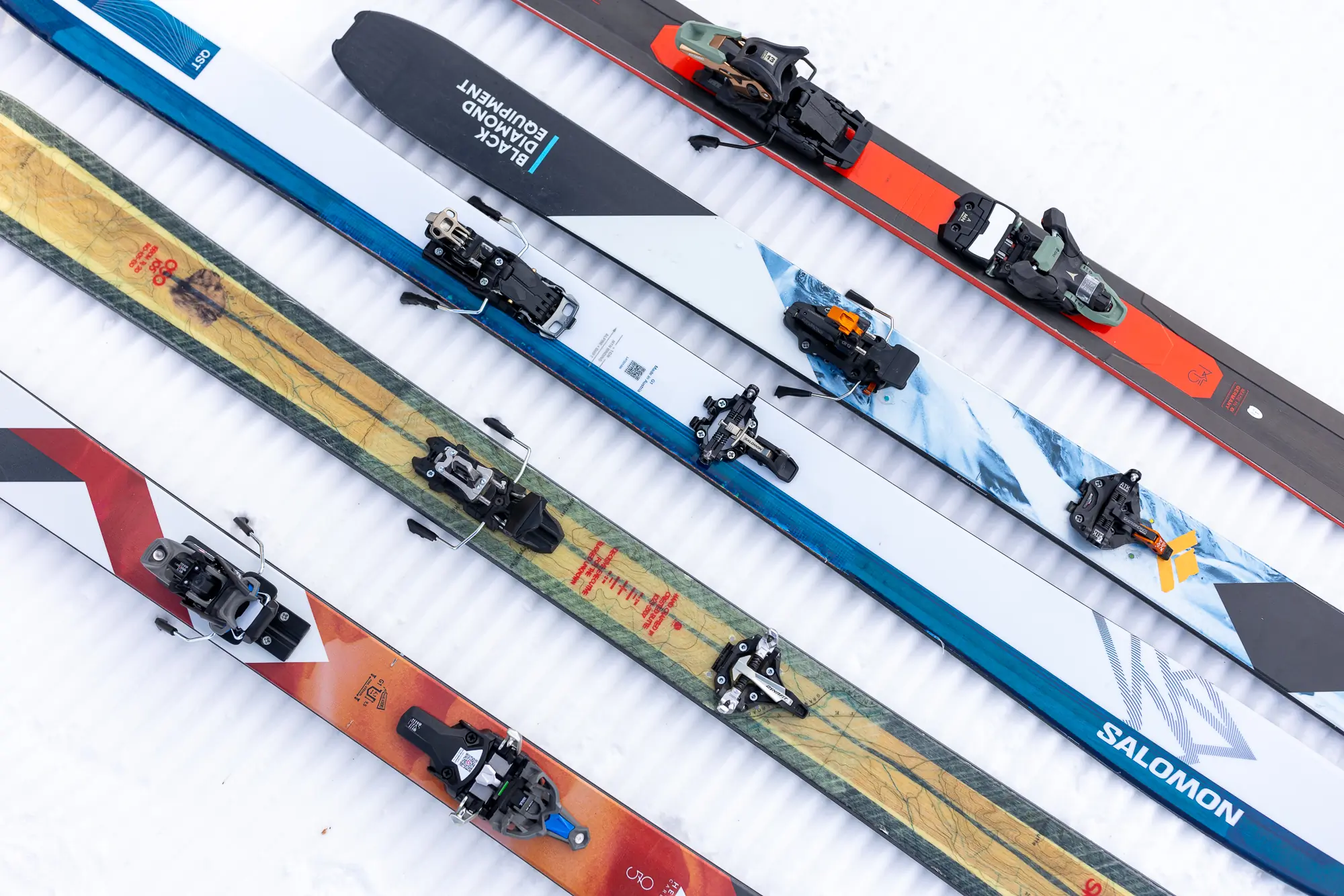
How We Tested the Best Backcountry Ski Bindings
Testing backcountry bindings involves thousands of vertical feet of climbing, scouting lines, evaluating couloirs, making smart choices on hut trips, quiet powder turns in the trees, and our fair share of unintended releases on the skin track.
For the ski-touring experts at GearJunkie, the real work also involves mounting and adjusting bindings, route finding on tours, waxing, familiarizing themselves with new technology, and stepping into unfamiliar toe pieces in deep snow.
Our Expert Testers
Writer, photographer, and lifelong ski bum Aaron Bible has been curating this guide from the beginning back in 2020. Aaron is an award-winning journalist who’s been covering the ski and outdoor industries for decades, and he brings his keen eye for detail and a knack for the written word to provide solid assessments of each binding in our list.
Calling Eldora Ski Resort home base for almost 20 years and another almost dozen years between Summit County and Steamboat Springs, Aaron has been testing touring bindings since they became readily accessible in North America, and he’s ridden the wave of technical advances in bindings, boots, skins and apparel which has led to the massive growth in the sport.
As the touring boot and binding technology kept improving, he permanently switched from telemark to alpine touring about seven years ago, and he hasn’t looked back. Typically racking up triple-digit ski days each season, he currently calls Monarch Mountain his home hill. However, when he’s not traveling around the country and the world for turns, he can also be found at Arapahoe Basin for mid-week uphill missions.
In 2024, we enlisted the help of backcountry enthusiast, ski tech, and master boot fitter Ryan Kempfer. Spending over 100 days in the backcountry each year, Ryan is the ideal person to put backcountry ski gear through the wringer. Will Brendza also contributed to this guide.
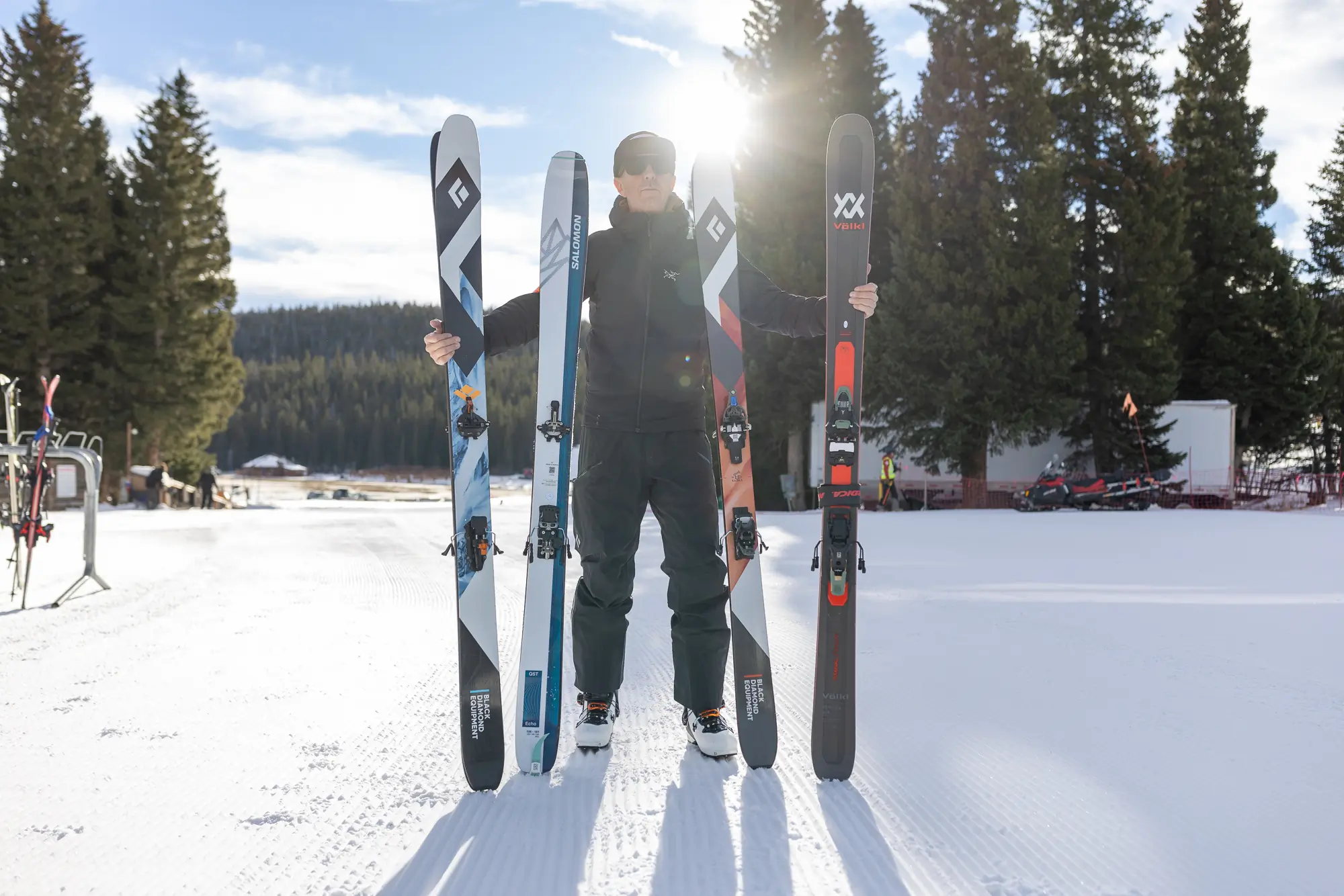



Our Testing Grounds
This year’s testing included many spring skiing, deep winter missions, and early-season excursions. We spent multiple days camped out in the trailheads of some of the best-known and lesser-known spots around the Rocky Mountains, skinning uphill at our favorite resorts around Colorado and many forays into the backcountry.
We also had to hit enough lifts to understand how these bindings and skis perform on the downhill in all types of conditions. These missions included Steamboat and Vail — including time spent in the backcountry off of Vail Pass; the Powder Highway and Red Mountain in Rossland, British Columbia; and from Monarch Pass and Monarch Ski Area to Mammoth Mountain in California; Copper Mountain and Loveland Pass, Jackson Hole, and more. All of this new tech has seen some serious wear and tear at the hands of our testers.
Our Testing Process
The best way we’ve found to evaluate backcountry ski bindings thoroughly is to simply go touring. Through miles walked, countless kick turns, and transitions, the user experience becomes clear. We pay close attention to how difficult it is to click into each binding (after a reasonable amount of practice), how it feels to adjust the risers from a standing position, and how they perform on the downhill.
Finally, we consider the weight of each product. In human-powered travel, a few grams can really add up. Like in all performance gear, it’s a game of compromises: the lightest bindings won’t have the best downhill performance, and the burliest bindings with the most features will never be a top choice for a multi-day tour. Typically, our favorite bindings fall somewhere in the middle, functional without weighing us down.
Complete your backcountry kit by consulting some of our other guides, including the best backcountry skis, the best avalanche beacons, the best backcountry ski boots, and the best climbing skins.




Our Backcountry Ski Binding Rating System
We rate backcountry ski bindings across four key categories: overall performance, ease of use, weight, and durability. Performance reflects how well the binding balances uphill efficiency with downhill power, whether that means climbing steep skintracks or driving wide skis in variable snow. Ease of use considers how intuitive the binding is to step into, switch modes, and operate in harsh winter conditions with gloves on.
Weight matters because every gram counts on long tours, so we evaluate how the binding stacks up for fast-and-light missions as well as bigger days with more gear. Finally, durability measures how well the binding holds up after repeated tours, abuse in cold conditions, and contact with rocks or ice.
Note: Each category is scored on a scale of 1 to 10, but the overall rating is not an average: it reflects our testers’ judgment of how the binding performs overall in the backcountry.
Buyer’s Guide: How to Choose the Best Backcountry Ski Bindings
The freedom of skiing without lifts — and hopefully without crowds — has been luring more and more people into the backcountry for years. Today, almost every ski area in North America has instituted some sort of uphill policy designed to allow affordable and predictable uphill access for those wishing to earn their turns and to keep everyone safe from snow machines and downhill ski traffic.
Purchasing backcountry bindings online allows you the time to research so you can find a touring binding that best fits your needs, goals, and budget. Backcountry bindings fall on a continuum, from light and minimalist for racing uphill all the way to heavier and more powerful for extreme downhill descents.
You can approach your quest for the perfect binding in a similar manner. Just like someone in a shop will, ask yourself: What are my primary objectives? How long will my days be? What distances will I be traveling on skis? How aggressive a skier am I? How many days per season will I be touring?
There are bindings best for short, speedy jaunts up the face of your local ski hill, bindings designed for long, technical tours, ski mountaineering, and racing, and some that are more downhill-oriented. No matter your speed, distance, or objective, the focus is on reliability and functionality. Weight is more of a factor for racing and highly experienced skiers looking to shave grams, because weight is speed, but it’s also safety when it comes to extended expeditions.
When selecting a backcountry binding for your touring setup, consider these factors — uphill and downhill performance, ease of use, weight, and durability.


How Will You Use Your Bindings Most?
While all of the choices in this guide can work as backcountry bindings, where and how you go touring will make a difference in which kind of bindings you end up buying. Many resorts have uphill policies, so some of you may primarily skin uphill in-bounds at a resort. If you’re mostly going out for the uphill fitness aspect and are skiing inbounds on groomers, something lighter, such as the new Dynafit Seven Summits, will be perfect for you.
If you plan to use your new setup at the resort and for the occasional backcountry trip, choose a binding such as the Atomic/Salomon SHIFT 2, which has safety and functionality much more like an alpine binding. These bindings will transfer more power on the downhill but come with additional weight. If you’ll spend most of your time in the true backcountry, we recommend a binding that is extremely durable and reliable, like the G3 Ion or the Salomon MTN Pure.
Once you determine what kind of skiing you’ll be focused on and how you like to ski, it’s time to narrow in on the details. Your skier type (consisting of ability level, age, and body weight) will affect the DIN rating you can get away with. This is determined by manufacturer standards and legal guidelines and set by your ski shop when they mount your bindings.
However, you don’t need to understand everything about DIN to buy the right pair of bindings. With the increasing breadth and depth of choices and advancing technology now available to North American skiers, you’ll certainly find something that matches most of your skiing.




Ease of Use
Tech bindings may look confusing at first, and while they are packed with some pretty complex technology, most of them are actually very straightforward to use. However, they are not all created equal. The way the pins snap into the inserts, at what angle, and with what force can make a difference.
For beginners, they take some getting used to, especially in deep snow where you can’t see what you’re doing. Everyone fiddles and misses the first time they try to click in. Some bindings feature toepiece indicators to help you line up your boot’s toe inserts to the binding’s pins.
Models such as the ATK Freeraider 15 Evo, G3 ZED 12, the G3 Ion, and the ATK Raider are known for their ease of entry, and that may be important if you are new to the sport. Usability and reliable, simple functionality are also safety concerns for more advanced skiers because safety lies in speed when the weather changes.
When you get your new bindings mounted, practice using them repeatedly at home or at the resort before you head into the backcountry. Start by aligning the inserts in your boot toe to the pins of your binding and stepping down with the front of your foot. Find the sweet spot. Practice clicking in and out of the toe piece.




Next, practice locking the toe lever. This is called Walk or Climb mode and prevents the pins from opening accidentally while skinning, as well as pivoting, on some models. Never ski downhill with this walk mode engaged. Be sure to read your instruction manual thoroughly to understand how many clicks are needed to fully lock out and how to use it safely.
Now stomp down in the back and lock in your heel. This will vary in hybrid bindings but is mostly the same in full-tech bindings. Also, stomp in while the heel is in climb mode, and you’ll feel the brakes lock up. Test out the different climbing riser levels available in your heel risers, and know how these risers feel under your heel, how to flip them up and down, and how they affect your climbing. This will make more sense on the skin track.
You’ll want to know if and when you can effectively manage the binding’s features with your ski pole or if you will need more power and leverage to make changes. This can lead to some frustration on your first few days out as you get the hang of what it takes to ski on backcountry bindings versus alpine bindings.
When it comes to transitioning from uphill to downhill, the ease of spinning the locking heel out of the way into a touring position is important. Some bindings are easier to spin and more intuitive than others. For example, the ATK Freeraider 15 Evo and the Salomon/Atomic MTN Pure are extremely easy and intuitive to transition.
The ATK Raider also makes it easy to transition from walking to skiing after you’ve done it a few times. Dynafit bindings require a little bit of elbow grease but work perfectly once you’ve mastered them.
Every touring binding has a front toe lever that locks the binding into touring or “walk”/“uphill” mode. This prevents unwanted releases while skinning, especially when making kick turns or on very steep grades. Never ski with the toe locked into walk mode, as it invalidates the DIN or release value and could cause injury.




Risers
Regarding risers: these are crucial to easily get up steeper grades. The ability to quickly and easily employ the uphill risers on the heel portion of the binding can make a massive difference in your efficiency. In fact, the options and levels of heel risers are sometimes the real differentiating factor for some of these bindings.
While there is much discussion around risers, and every old grizzled backcountry skier has his or her own opinion about risers, they are actually a crucial part of efficiently getting up the mountain. Heel risers, climbing risers, or lifts vary dramatically in form but are always some little piece of metal or plastic that flips up or over from the heel piece to give you more of an angle for climbing steeper grades.
Some bindings only have one riser, while others, like the ATK Freeraider 15 Evo, have three settings for more options for variable terrain. Of course, this also means you have to stop momentarily (hopefully) to switch them out, but it makes climbing so much more enjoyable.
We’ve been on steep or icy terrain where climbing without risers (or crampons) is practically impossible. You can definitely be faster and more efficient with the right riser on a steep climb up the front side of the resort.
Sometimes, on gently rolling terrain, it’s also nice to be able to quickly and easily switch between riser and flat with just the practiced flick of a ski pole. Personally, we like options, just as long as they are well-engineered and easy to engage and disengage with our poles; otherwise, we are less likely to make changes and just slog it out.
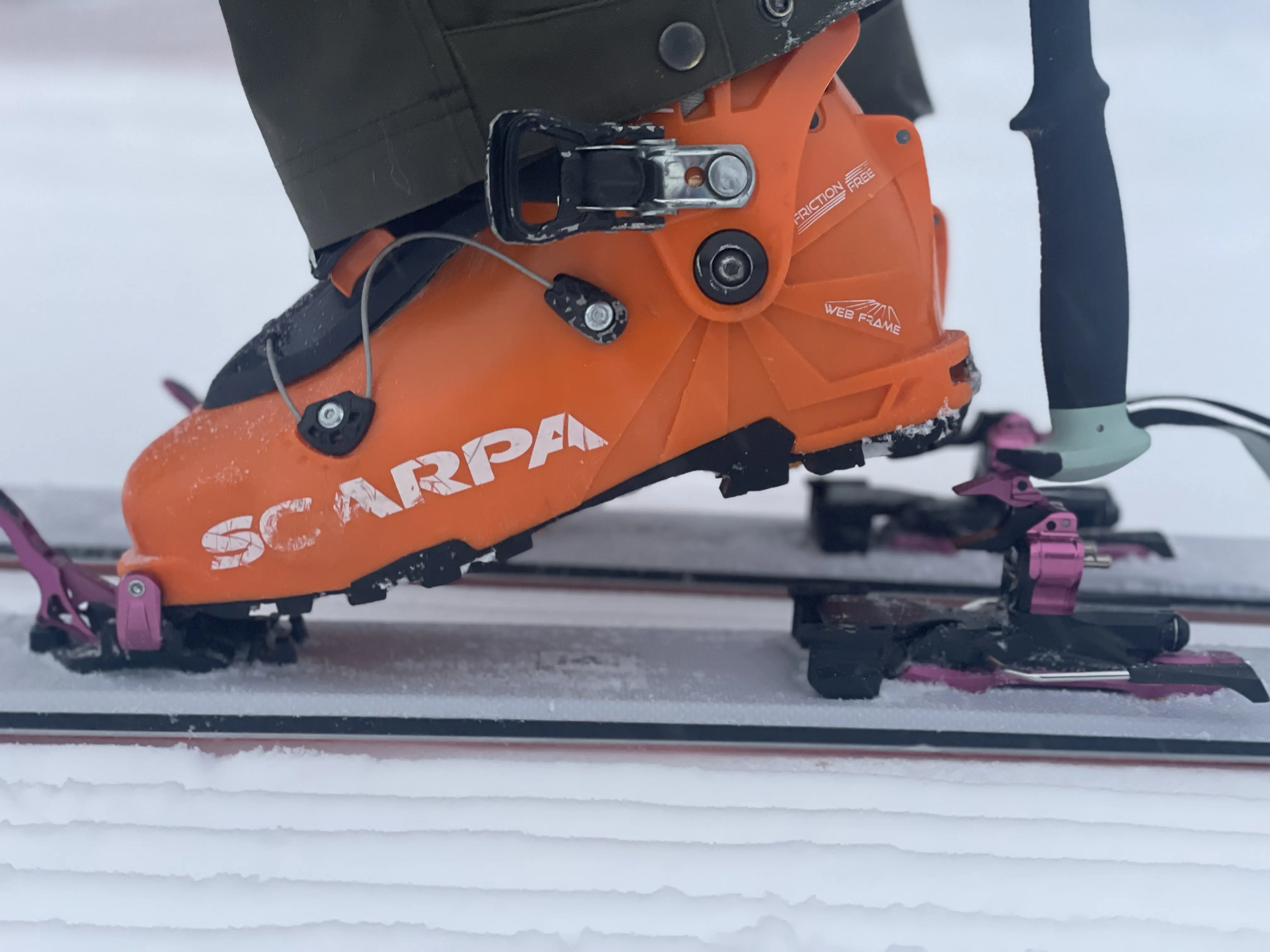



Weight
Lighter bindings make uphill travel easier and, therefore, faster; if you’re racing or crushing FKTs, check out the Dynafit Superlight 150. However, also consider that this binding will give you less stability and power on the down. Alternatively, if you’re going with a relatively heavier binding, such as the Salomon SHIFT 2, you’ll pay for it on the way up, but it will have more power on the down. The weight you choose will depend on your goals.
If you’re mostly into casual touring or hut trips, to name just two use cases, being ultralight probably isn’t your main concern. For many skiers, even those out doing long tours and bagging peaks, it’s not a race. For many of us, it’s a good idea to be light and have comfortable boots, but we also don’t mind carrying a little bit of extra weight in a wider ski or a slightly heavier boot, and therefore, at that point, a mid-weight binding like the Salomon Pure would be ideal.
If you have goals of ski mountaineering races or uphill/downhill races at your local ski hill, then you will want to look at the Dynafit Superlite 150 or a similar touring binding with a focus on minimalism and light weight. However, these bindings do come with sacrifices, namely in release technology and, therefore, safety.
If you are a heavier or more aggressive skier who takes jumps, skis bumps, and rips long, dynamic runs in bounds, then a burlier binding is more appropriate. You won’t notice the small amount of added weight, especially if you are coming from an alpine binding.
Brakes, the type you might be familiar with from downhill alpine bindings, are omnipresent on touring bindings now as well. But many people forgo them if they are only skiing in the backcountry. Small leashes are lighter weight, less prone to snagging, and do the job of keeping you from losing a ski in deep snow.
It is typically against the rules to ski in-bounds without brakes of some kind. For this reason, if you are going to be riding lifts with your new setup, it is recommended to just go with the brakes. Unless you are an expert, a ski-mo racer, or some other kind of weight weenie, brakes are a major plus.
They keep your skis from sliding around when you don’t want them to, and they make it easier to click in. They can also really come in handy when you’re standing on top of a windy, hard-packed peak trying to get clipped in before your ski slides or blows away from you, leaving you in a potentially dangerous situation.




Durability
Most, if not all, of these bindings are highly durable, but this can vary. For beginners, something very durable, such as a Marker Alpinist 12, or something known for its ease of use, such as the G3 ZED 12, gives you great reliability, a middle-of-the-road weight class, and a good mid-range DIN.
As stated above, it’s safe to say that any backcountry touring binding is going to be durable. Really, its one job is to hold up to extreme conditions. So, if you have any issue with a binding’s durability, the manufacturer will almost certainly warranty it.
That said, some are more durable than others. Plastic breaks more easily and more often than metal. Fewer moving parts and less complex technology tend to be more durable over time. These bindings are going to get stomped, thrashed, banged against rocks and ice, frozen, unfrozen, beat, but hopefully not trashed.
So avoid any unnecessary dropping of your skis off of rocks and vehicles, don’t stomp on them too hard in the wrong places, and overall, take a bit of care with this very expensive piece of life-saving and fun-enhancing equipment.
Again, simplicity typically equals durability, so something like a Dynafit Superlite 150 or Seven Summits is literally guaranteed to be the utmost in durability. Some manufacturers that employ more plastic parts, such as the Fritschi Xenic 10, could be more susceptible to breakage when not used correctly. Atomic/Salomon bindings also continually score well on durability.
Bring your skis inside at night when possible so that you are not stomping on frozen parts first thing in the morning. Also consider how much you’ll be traveling with your skis and what type of conditions you’ll encounter to even get to the backcountry. Early-season skiing is bound to put more wear and tear on your gear. Additionally, invest in a nice padded ski bag, and inspect and dry your skis and bindings, as well as your skins, after each use.
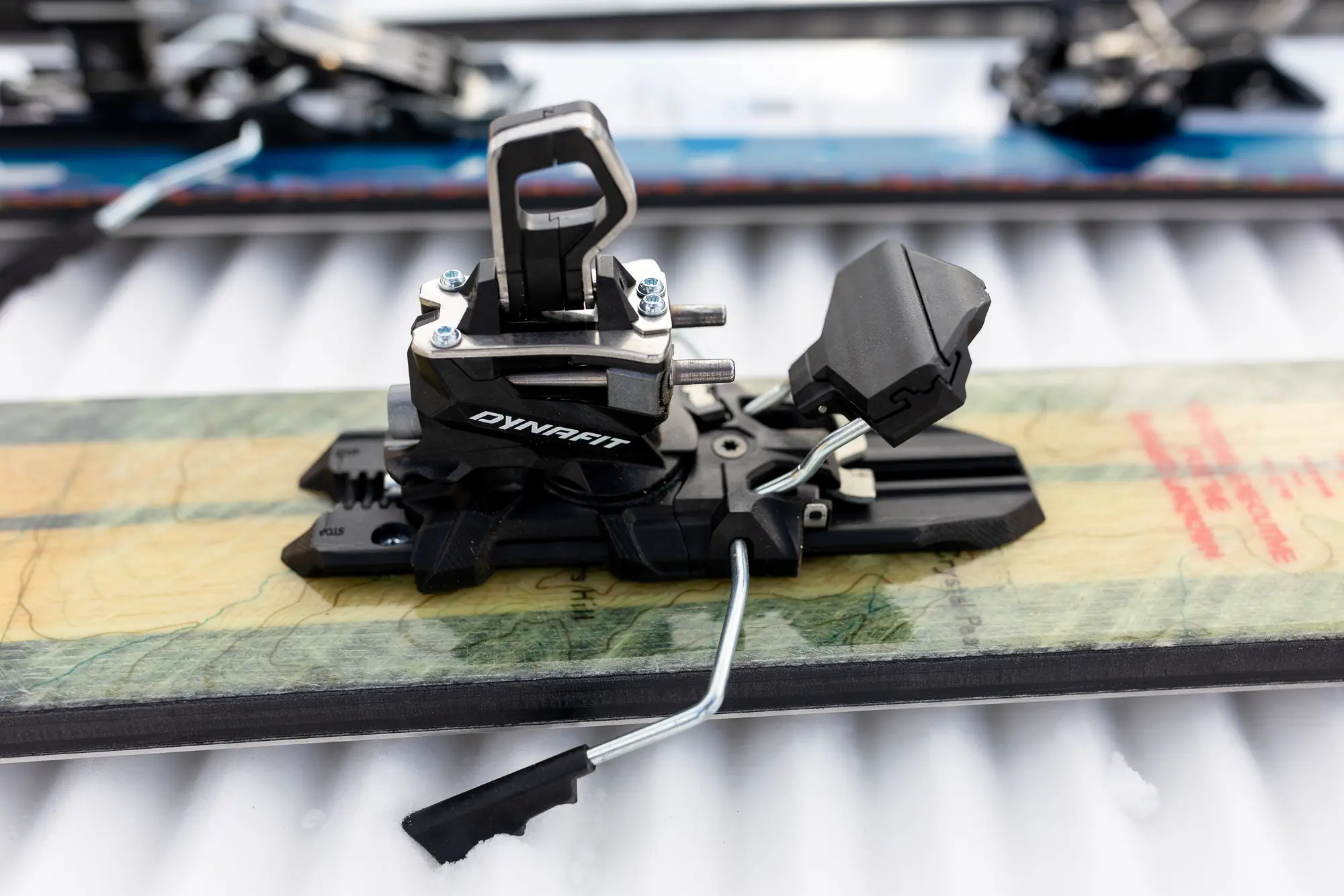



Boots
To get started, make sure that your boots are compatible with backcountry skiing bindings. That is, do they have tech pin inserts on the toes and tech heel inserts on the back?
Another pair of boots is costly, yes, and a pair of frame bindings may be compatible with your alpine or resort boots, but skinning in those boots can be pretty uncomfortable.
Tech bindings require backcountry ski boots with the molded-in toe fitting originally developed and licensed by Dynafit; and a slotted plate at the heel. Currently, most alpine touring boots will work with most alpine touring bindings. To be safe or if you’re unsure, triple-check to make sure that your boots and bindings are compatible, either by contacting a shop or the manufacturer, before buying.
When deciding on touring boots, consider the type of skiing you plan to do. Fast and light alpine touring or ski mountaineering boots cut weight to help you travel uphill fast, but they often lack the power and stiffness of alpine boots. There are also plenty of four-buckle touring boots that are high-performance and ALMOST as stiff as your resort boots, but not quite. And there’s lots in between.
Crossover boots are a great option if you plan to ski at the resort and take some backcountry trips with your setup. The new K2 Mindbender is a great example of this type of boot. They’ll be heavier on the uphill, but they’ll dominate the downhill, letting you ski as aggressively as you like. Check out our guide to the best backcountry ski boots to learn more about your options.




Price & Value
Backcountry ski bindings are available at a wide range of prices. Similar to our discussion of price and value in our guide to the best climbing skins, there isn’t always a clear or linear correlation between what you get at different price points. Factors like brand name, weight, durability, technicality, and uphill or downhill performance may play a role.
Budget
Usually, as backcountry ski gear gets lighter, it gets more expensive. However, as we see our budget pick, the Dynafit Seven Summits bindings (640g/pair) fall in the middle of our list regarding weight, yet they are also the least expensive at $350. Perhaps that’s because these bindings show a return to minimalism. Their simplicity makes them easy to use and reliable. However, more aggressive, heavier skiers may find that downhill performance is lackluster compared to other pricier models. For the price, this is a great deal for most people who head into the backcountry.
Mid-Tier
Bindings in the mid-tier range cost $500-599. Durable, reliable, and straightforward, backcountry bindings at this level get the job done. The Fristchi Xenic 10 ($520) is an affordable, safe, lightweight option that performs well but comes from a brand that fewer skiers are familiar with than some of our premium bindings.
The G3 Zed 12 ($572) is an excellent binding that’s easy to use, reliable, and has extra features, like a mechanism to reduce snow buildup, which you would expect to see in a pricier option. Plus, these, like all G3 bindings, perform better than most on the up and the down.
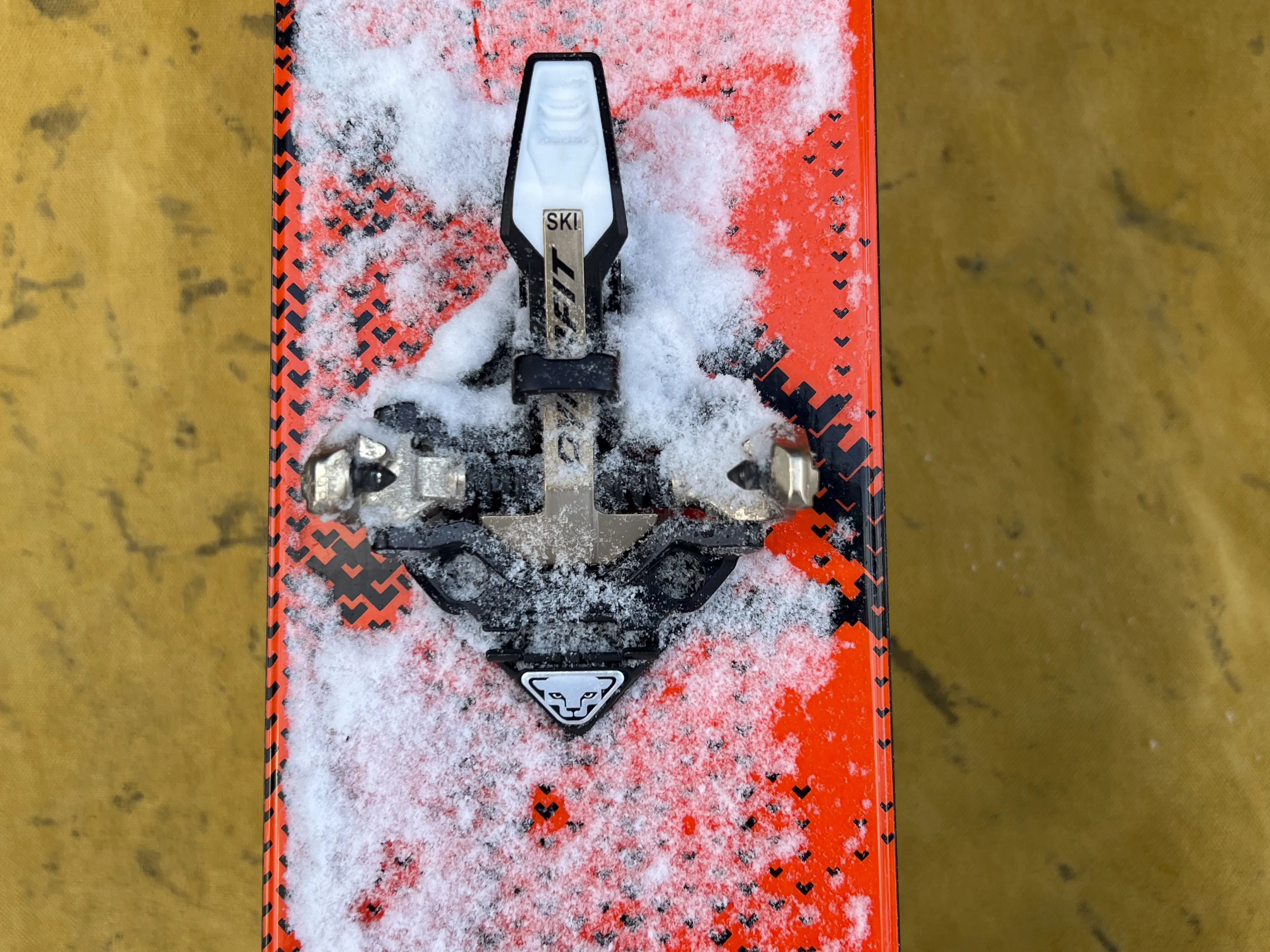



Premium
You will pay $600 or more for a touring binding in the premium range. All of our top picks, except our budget option, fall in this price tier. These bindings might cost more because they’re more technical, extremely light, perform well on the up or the down, or some combination of these factors. Sometimes, they excel in more than one of these areas, but often, there are compromises even at this level.
Our top overall pick, the Salomon MTN Pure ($650), strikes the ideal balance between lightweight uphill functionality and downhill power transfer in a safe, reliable binding. Still, it might be a bit advanced for beginners to easily use. The ATK 13 Raider Evo ($700) is a super high-quality performance binding sure to wow you with its ease, durability, and skiing performance. Similarly, the ATK Freeraider 15 Evo ($760), our most expensive option has a large number of thoughtful features that make it worth the extra money, especially if you want a binding that is lightweight but skis downhill with power and stability.
However, it’s not ultralight. The Dynafit Ridge Bindings ($600), which won our most innovative design award, are high-performance, well-designed, and highly functional for ambitious backcountry skiers who value speedy, easy transitions. Still, we’re concerned about how all the small moving parts will do in the cold over the long term.
As you can see, even the best bindings require compromises, so it’s important to do your homework and choose a backcountry binding best suited for your needs and skiing style.
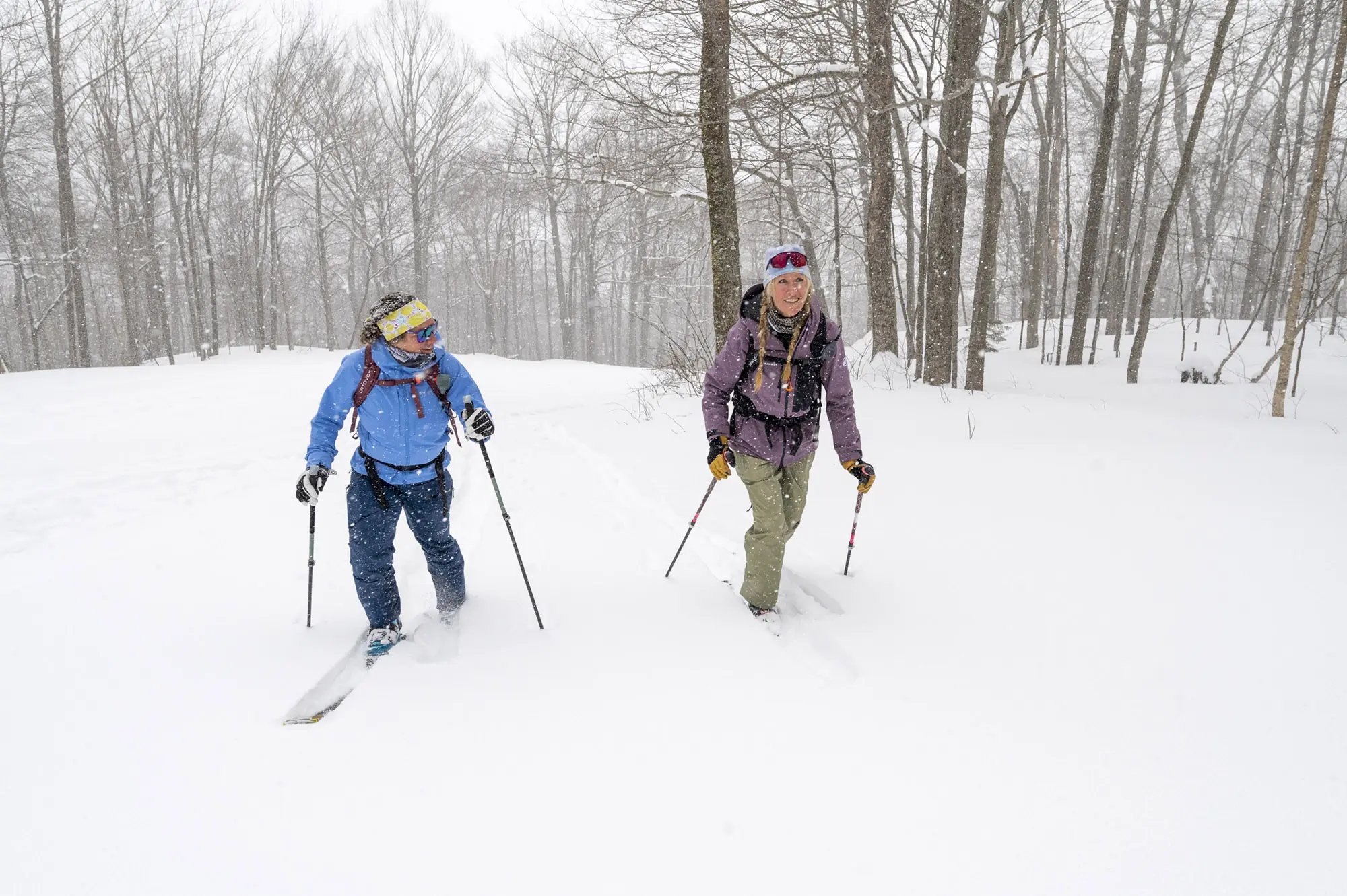



Frequently Asked Questions
Backcountry ski bindings are, in many ways, completely unlike your traditional downhill bindings. It’s good to consider them in a different light, although the goal of affixing your boots to your skis remains the same.
Backcountry bindings are different from resort or downhill bindings in that they employ a releasable heel but, in most cases, not a releasable toe. At least, that’s how they started out, and many of the more touring-focused bindings are still this way. When clicking out of most backcountry ski bindings, you will release from the toe instead of the heel, but that’s not universally true.
Alpine touring (AT) bindings allow you to change your settings so you can stomp down and lock into the heel and ski down. The bindings work by holding the boot in two distinct ways: from the toe only, with the heel piece out of the way for uphill touring, or locked in, with both the toe and the heel secure for downhill skiing.
The simple answer is that bindings work by holding your boot to your skis. They are the critical connection between your two most important assets: your boots and your skis. It’s crucial that your bindings are mounted by a professional to your specific boots.
So, we do recommend starting with your boots. You will have your boots for several seasons at least, whereas you could end up getting new skis every year. The bindings are an expensive and important investment in this system. They can easily be pulled off and remounted onto other skis at any shop.
With that, AT or backcountry ski bindings have essentially evolved into two modern camps. Camp one is born from the traditional Dynafit system, where the bindings release from the toe and are held to the boots with two contracting, nonadjustable pins. These snap together into holes on both sides of the toe, or welt, that sticks out about a half-inch from the toe of the ski boot.
The rear features another female insert that two pins fit into to hold the heel down during ski mode (downhill). The rear pins rotate out of the way when touring uphill, and this is also where you adjust for sole length and DIN.
Meanwhile, the second camp uses the rear heel welt like a traditional alpine binding to lock the heel down in ski mode. This newer type of backcountry touring binding also employs a way to use the front welt to lock the toe down in addition to the pins.
Yes and no. As long as your ski boot has tech inserts, the boots are essentially universal, but you can’t put a traditional alpine boot in backcountry ski bindings. Nearly 50% of all ski boots sold today have tech inserts. Alpine touring bindings typically fall into two categories: tech bindings and frame bindings.
Tech bindings use pins to attach to the front of your boot at the toe, and the heel piece is separate. In contrast, frame bindings look more like a traditional downhill binding.
The name refers to the frame that runs from the toe to the heel underneath the sole of your boot. This is the part of the binding that will raise and lower with your feet while you are touring uphill.
Every binding is designed to adjust to fit the sole length of your boot. While some bindings let you make small length adjustments, say 6-10 mm, others only allow for more minor adjustments to accommodate boot fit to the original mount.
If you do alternate boot sizes, consider a binding like the Marker Alpinist that gives you 15 mm of adjustability, so you can use boots with different sole lengths. That said, this should truly be done at a shop to ensure that the bindings are adjusted exactly to your sole length and that DIN has not been compromised.
Your binding DIN settings take several factors into account, including your boot size, the terrain you ski, your height and weight, and your level of experience. While you can make small adjustments on your own, you should go to a certified ski technician to mount your bindings and make major adjustments.
Bindings have a range of about 25-30 mm of adjustability to allow you to change boot size a little bit up or down. Brands in the same shoe size can vary 3-5 mm in length difference, so your binding will accommodate that.
Some people start with a more alpine-centric binding, such as a Salomon, their first year, and then a Dynafit or a more touring-focused binding the next year because they want to go farther, longer, and stay more out of bounds.
In a perfect world, you should buy your bindings based on your objective. If you are planning for mostly uphill skinning at your local ski resort with groomers on the way down, you should consider something lighter, with a lower DIN, maybe simpler, and possibly less expensive.
The farther and more extreme your terrain, the more important other factors — including weight and features — come into play. Look for multiple levels of heel risers (simpler race-style bindings may only have one level of heel riser, while more full-featured bindings might have three levels).
Consider whether or not you really need brakes (for resort skiing, you do need brakes to legally board a lift). A multiday high alpine tour would call for a lighter, simpler binding than hike-to or short side-country runs.
Less aggressive skiers need to worry less about ejecting from their bindings in an untimely manner. Hopefully, you can extrapolate this into what you want to do, what you can afford, and what’s actually available. Then, pair that with the right skis and make sure you’ve got compatible boots — and go skiing!


The Best Backcountry Skis of 2025-2026
We tested the best backcountry skis from Atomic, Black Diamond, Salomon, Voile, and more to help you find the best option for your needs and budget.
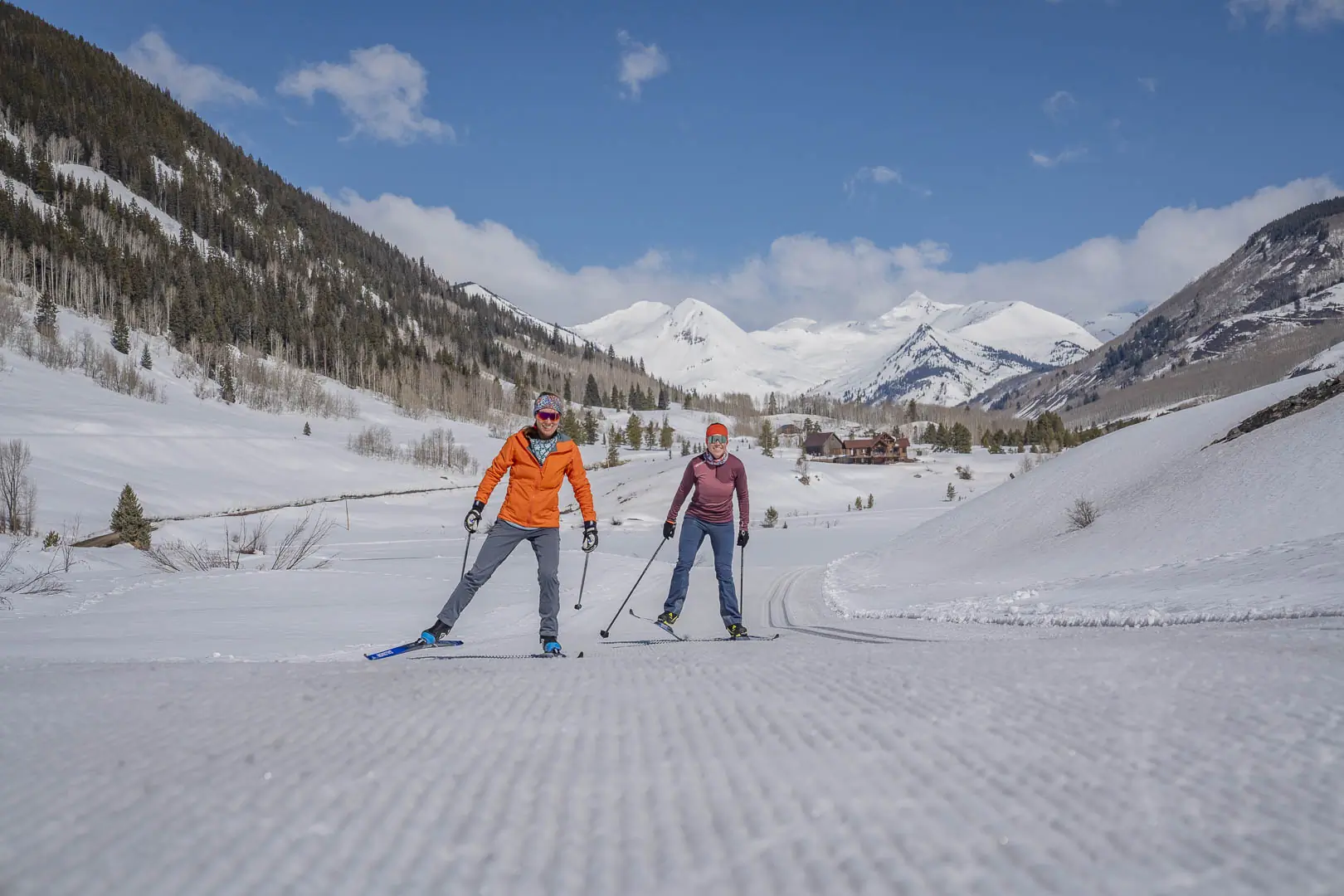

The Best Cross-Country Skis of 2025
We tested the best cross-country skis from Atomic, Rossignol, Salomon, and more to help you find the best option for your needs and budget.
